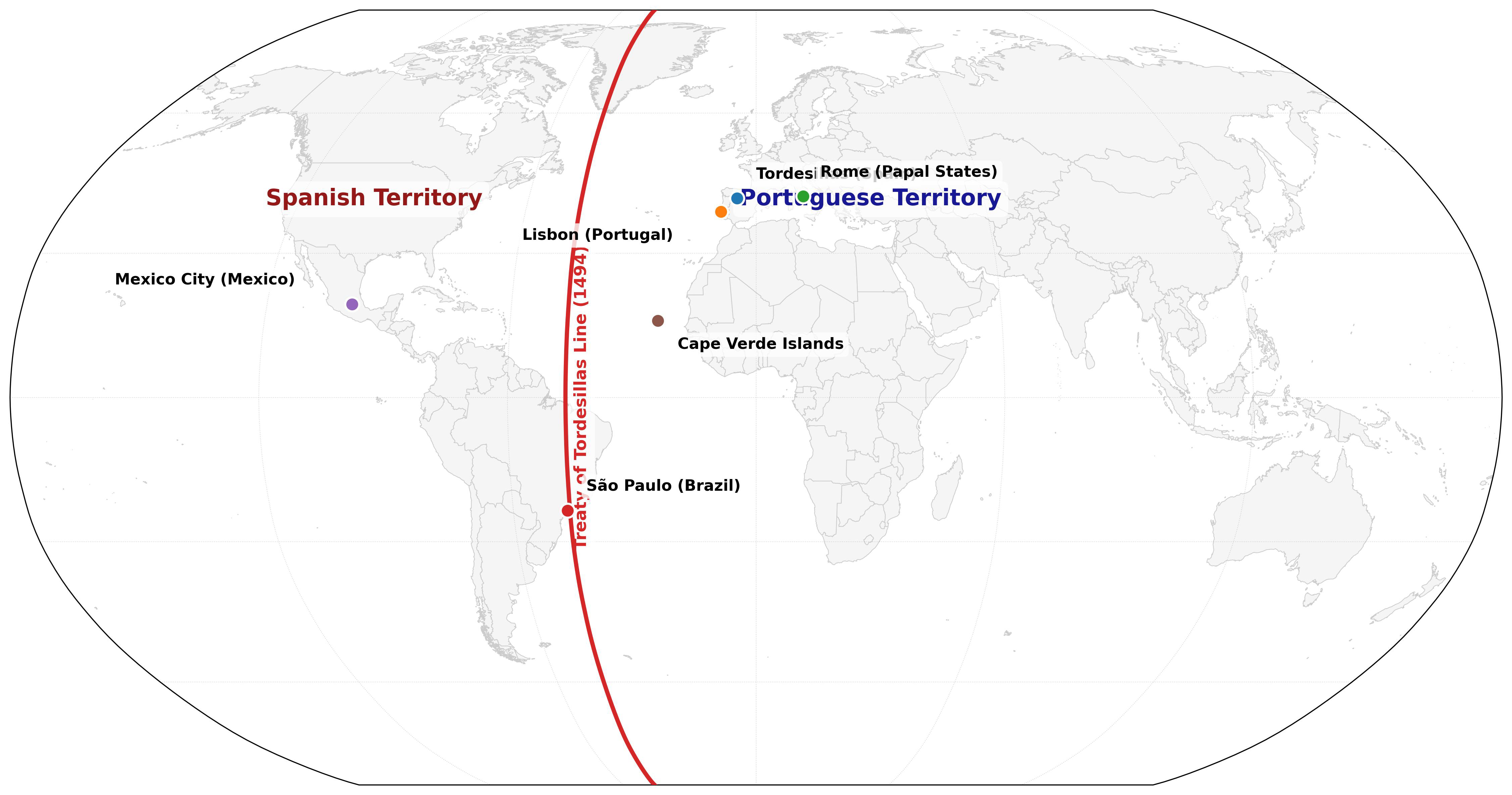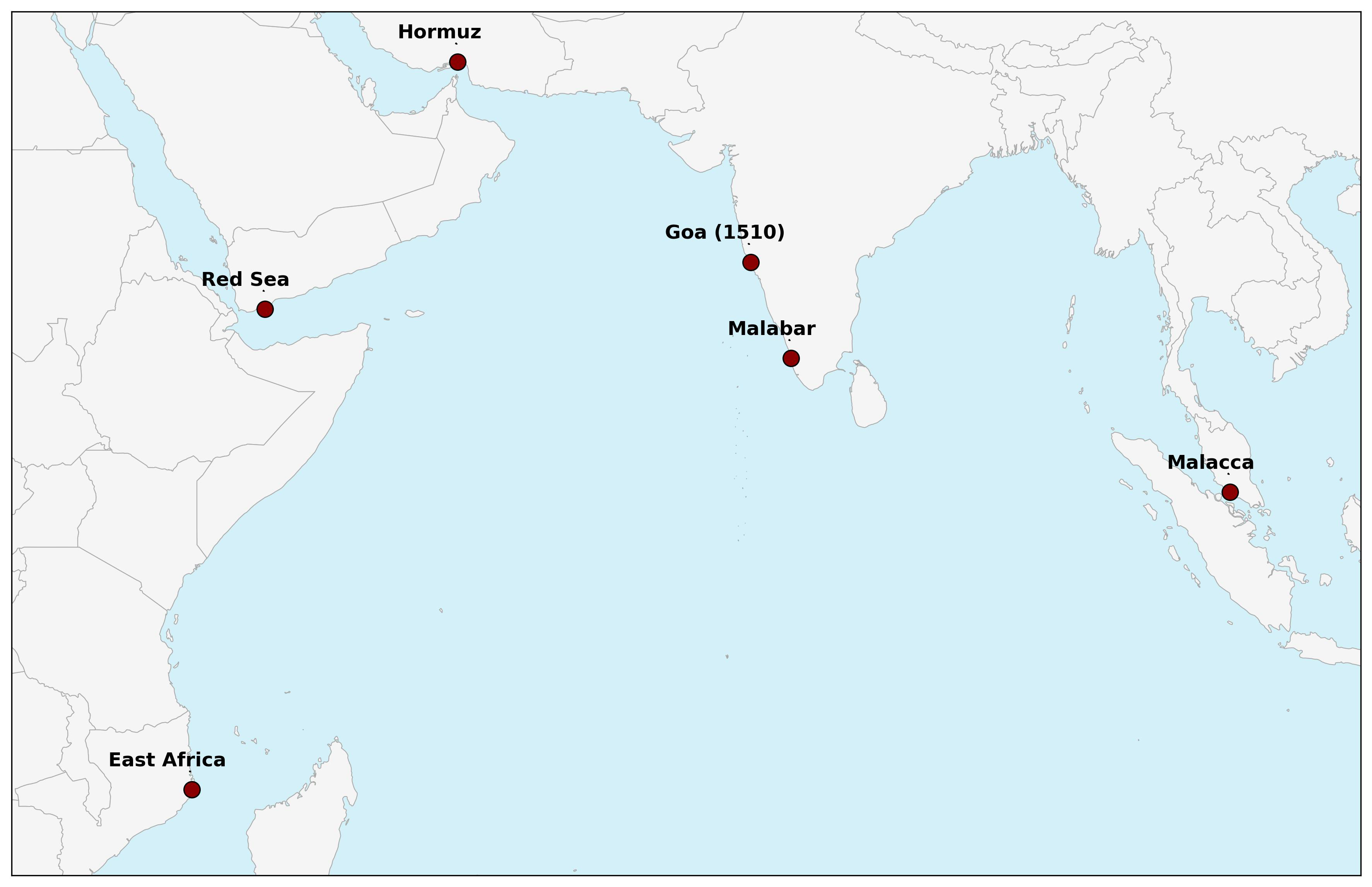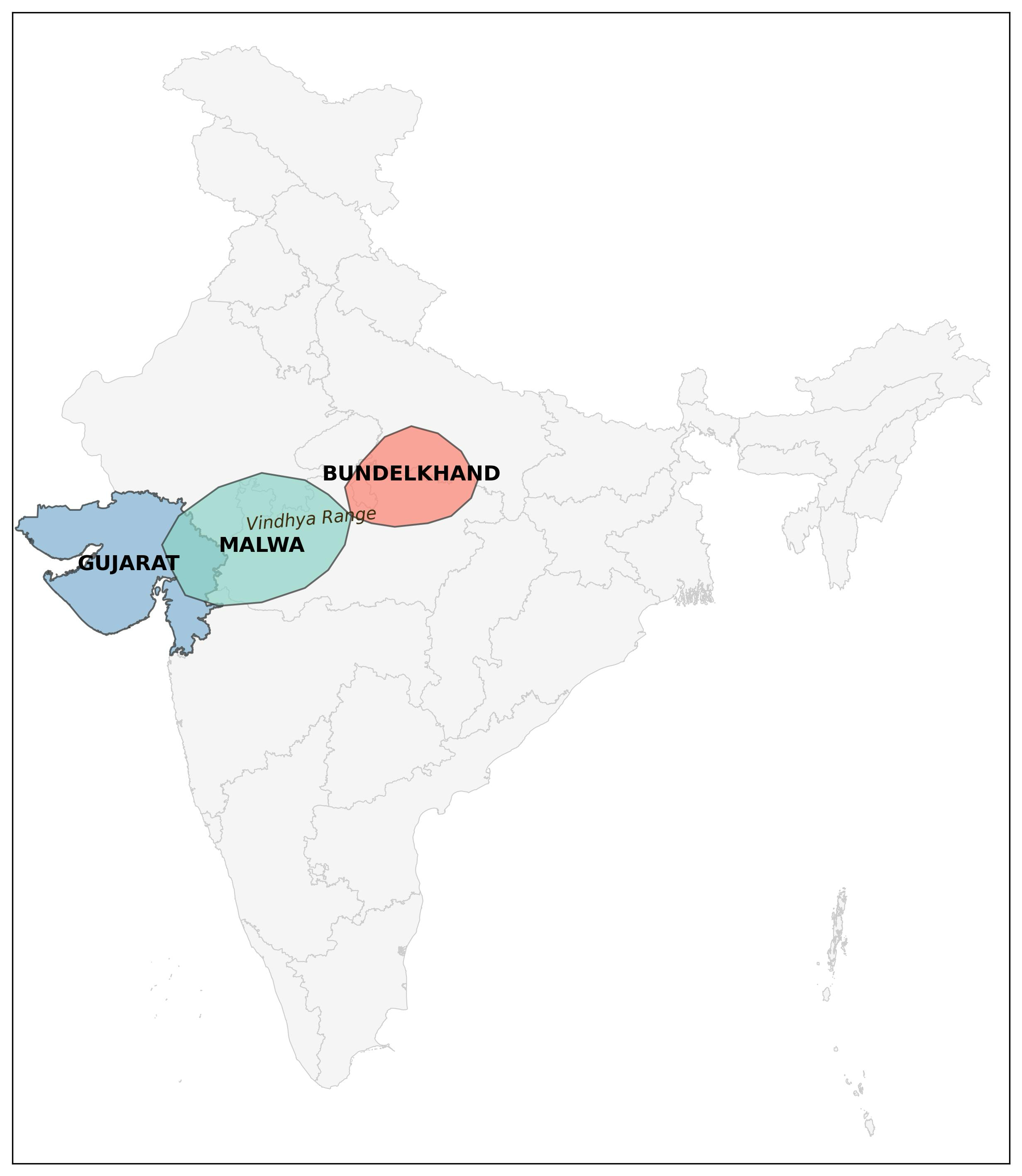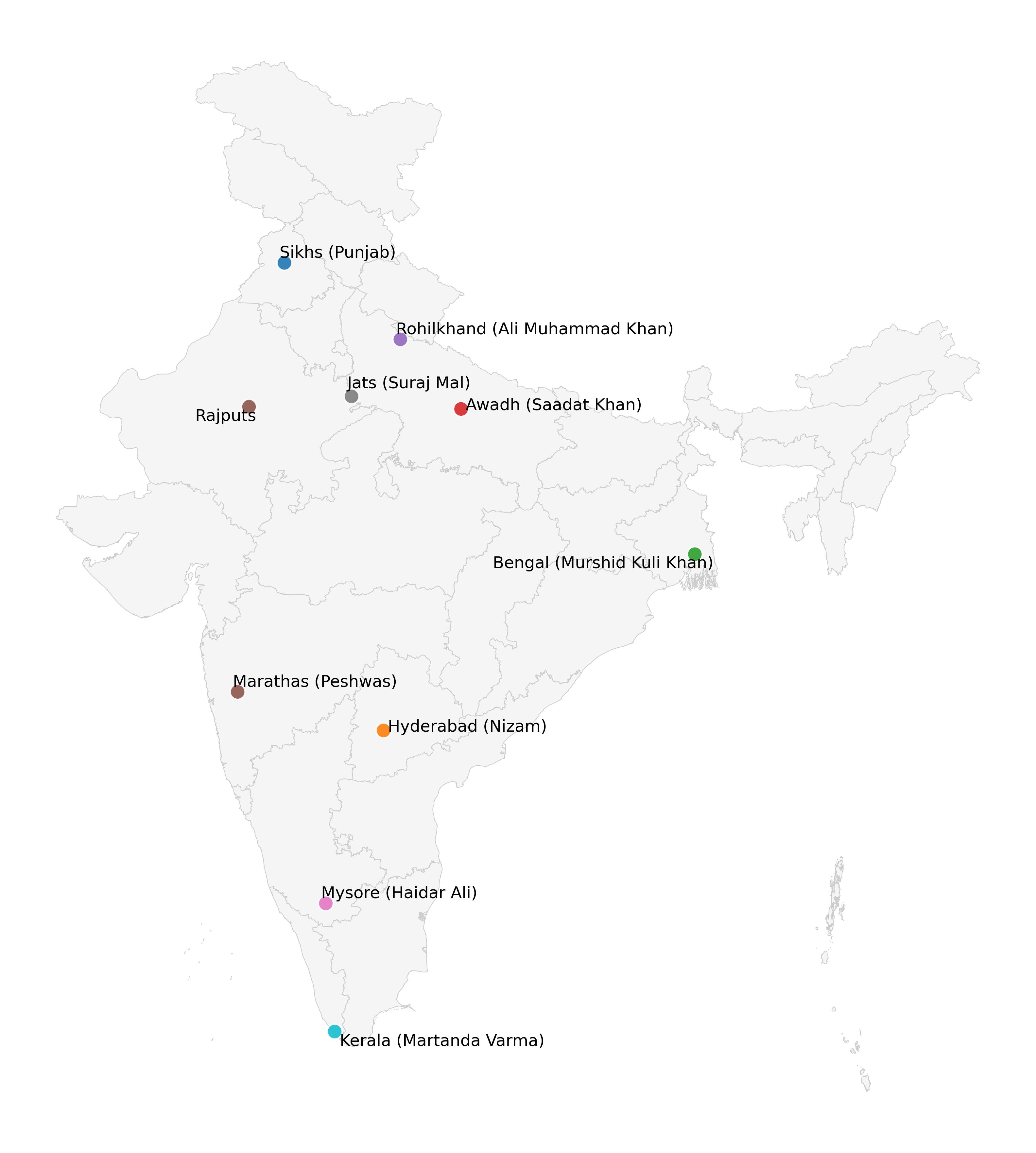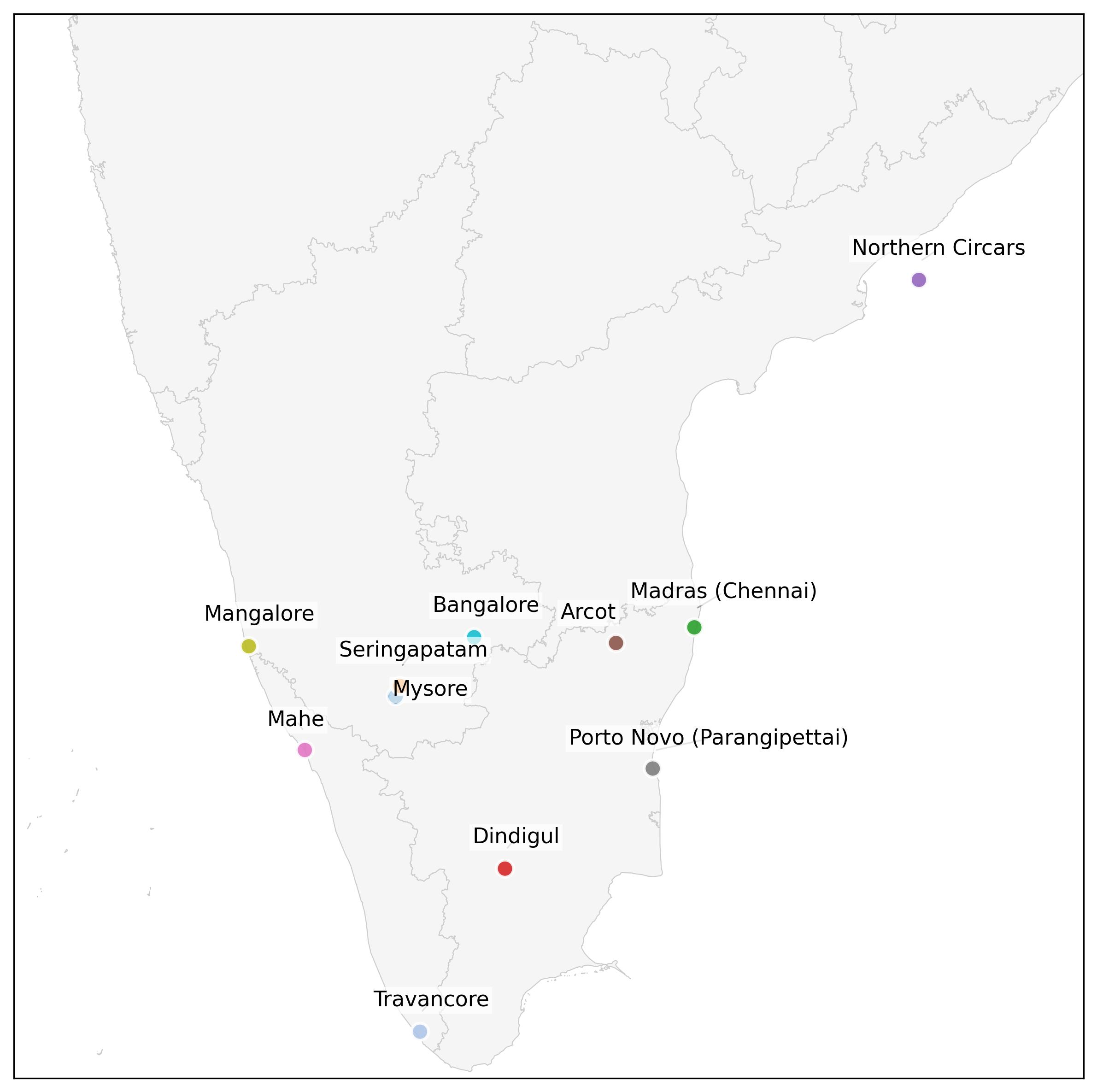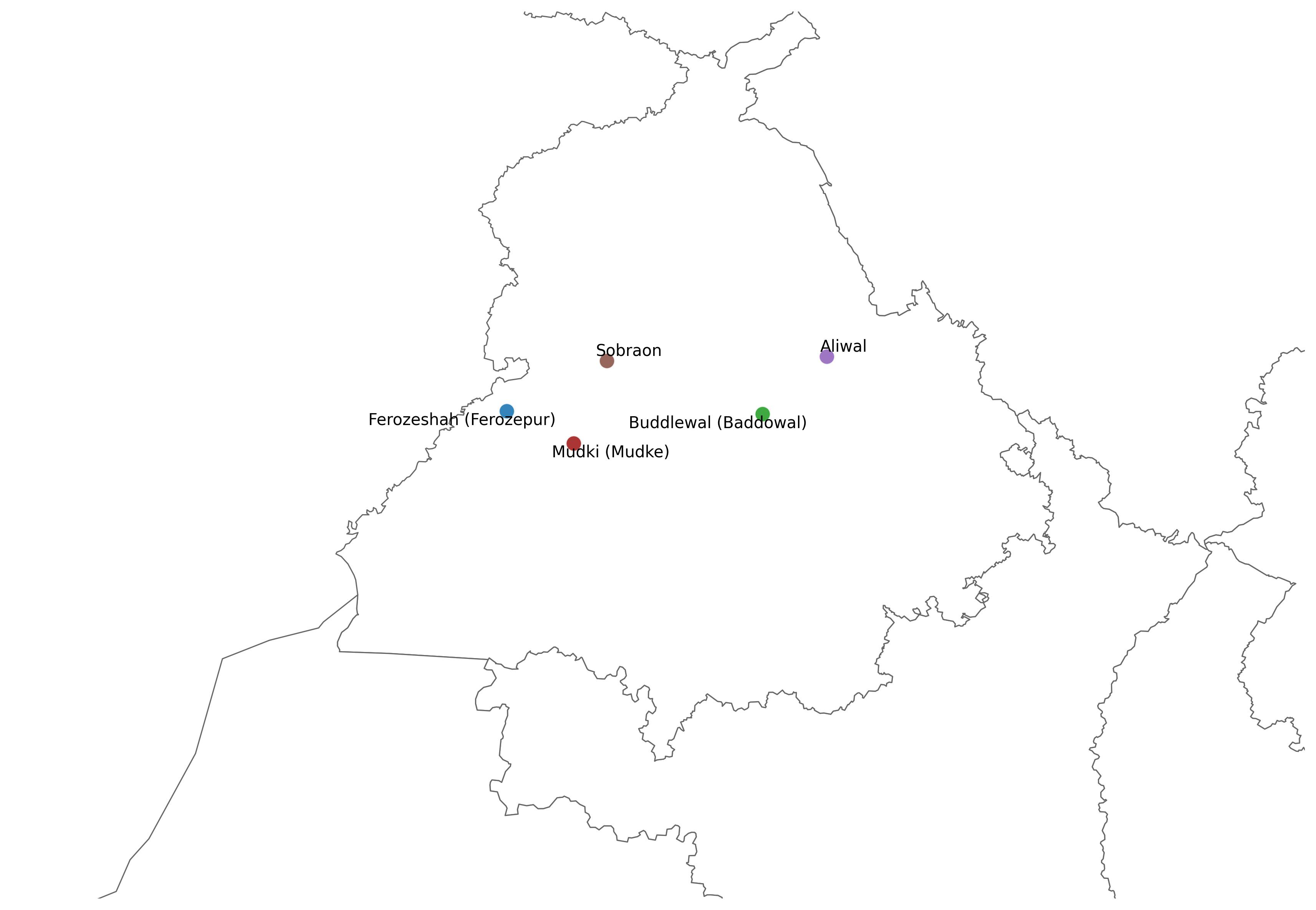3. Advent of the Europeans in India
Portugese
The quest for and Discovery of a Sea Route of a Sea Route in India
- Trade context
- 7th century: Arab domination after Roman decline limited Europe-India direct trade
- 1453: Ottoman conquest of Constantinople reinforced Muslim control of trade routes
- Indian goods (spices, textiles, luxury items) reached Europe via Arab intermediaries
- Europeans sought direct sea route to bypass Muslim monopolies
- European capabilities
- 15th century: Renaissance exploration spirit coincided with naval technology advances
- Agricultural improvements and prosperity increased demand for eastern goods
- Venice/Genoa too small for major expeditions; northern Europeans backed Portugal/Spain
- Genoese provided maritime expertise to Portuguese explorers
- Portuguese leadership
-
Portugal combined anti-Islamic stance with exploration ambitions
-
1494: Treaty of Tordesillas divided non-Christian world between Portugal/Spain
-
1487: Dias rounded Cape of Good Hope
-
1498: Portuguese reached India
-
From Trading to Ruling
Portuguese Generals
Vasco Da Gama
- Zamorin (Samuthiri), Hindu ruler of Calicut → Gave friendly reception → Not apprehensive about European intentions due to Calicut's entrepot status
- Arab traders apprehensive about Portuguese presence
- Sought monopoly of trade by excluding competitors
Pedro Alvarez Cabral
- 1500: Established factory at Calicut (Kozhikode)
- Conflict with locals: Portuguese deaths: Cabral retaliated against Arab ships
- Made treaties with rulers of Cochin and Cannanore
Vasco Da Gama Returns
- VDG returned in 1501
- Zamorin declines exclusion of Arabs ⇒ rupture between Zamorin and Vasco da Gama
- Factories in: Calicut, Cannanore, Cochin → fortified
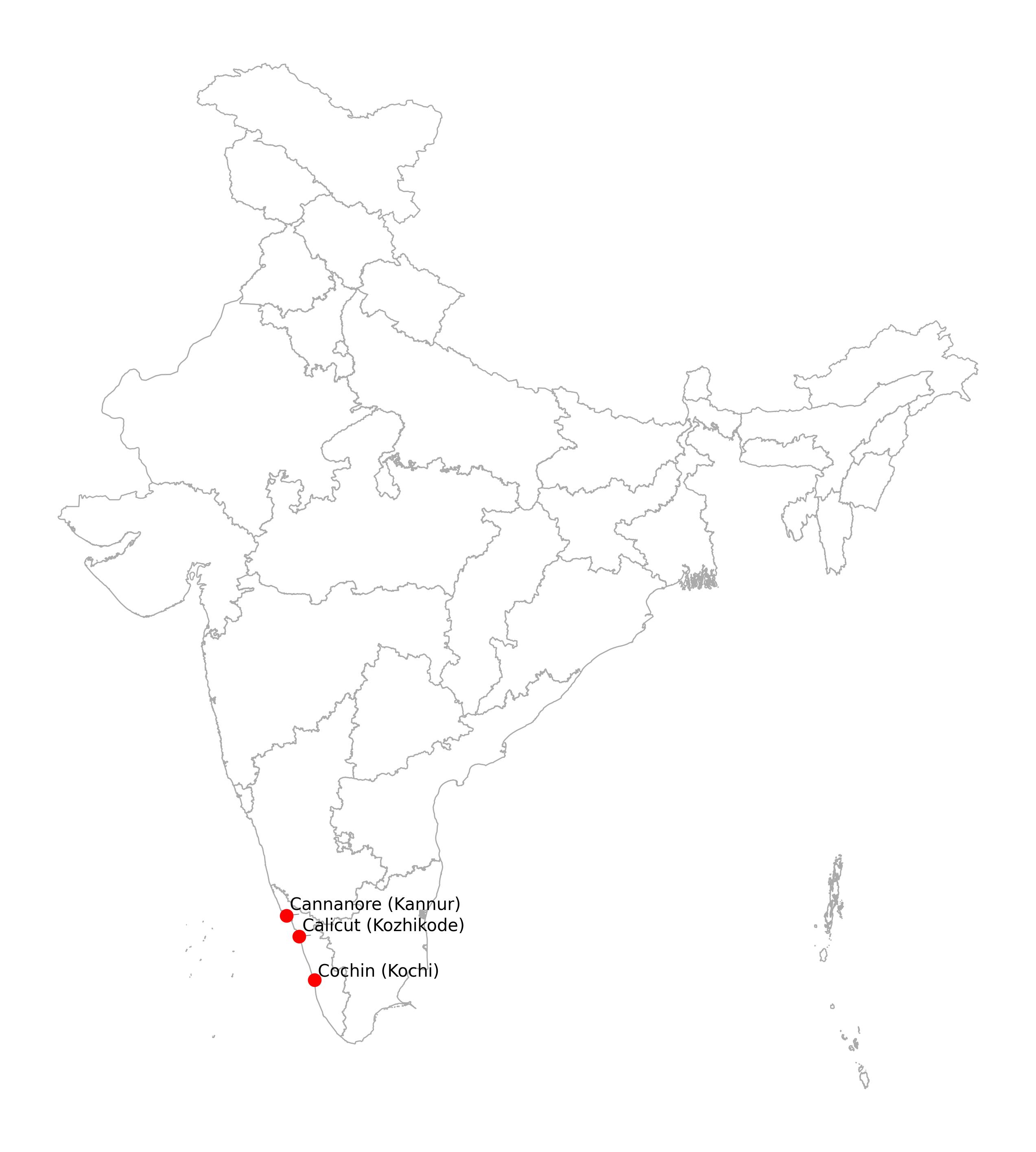
Francisco De Almeida
-
Appointed governor of India in 1505 by king
-
Mission: consolidate Portuguese position, destroy Muslim trade
-
Targets: seize Aden, Ormuz, Malacca; build fortresses
-
Faced opposition from Zamorin and Mameluke Sultan of Egypt
-
1507: Portuguese defeated by combined Egyptian-Gujarat navies
-
1508: Almeida avenged defeat by crushing both navies (Egypt + Gujarat)
-
Implemented "Blue Water Policy" (cartaze system) → Merchant needed to purchase a permit (Cartaz)
-
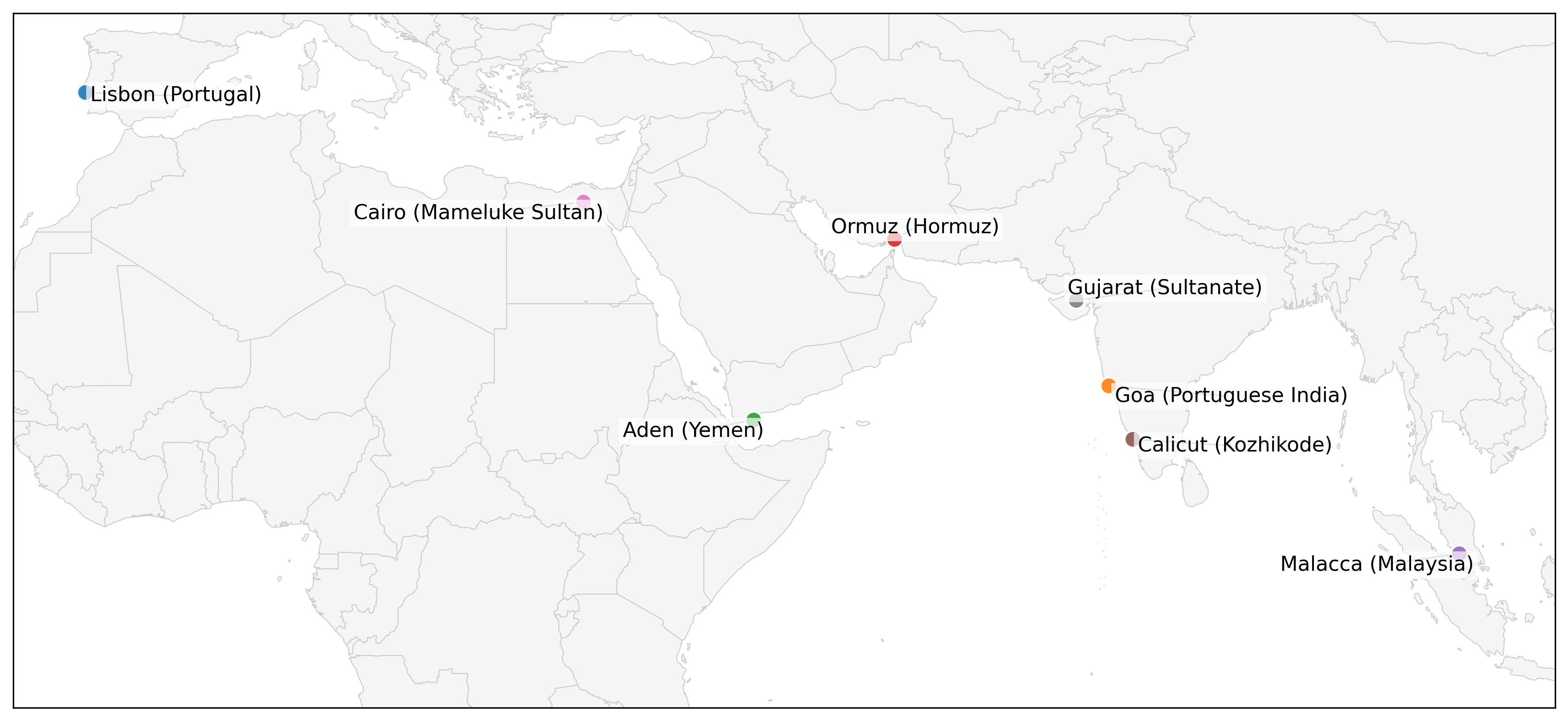
Alfonso De Alburquerque
-
& Real founder of Portuguese power in East
-
Secured strategic control of Indian Ocean with bases at key entrances
-
Established strongholds in East Africa, Red Sea, Strait of Hormuz, Malabar, Strait of Malacca
-
Implemented permit system for ships
-
1510
-
Built fort at Bhatkal (Uttara Kannada district) with permission of 11. Regional Kingdoms#Krishnadevaraya 1509–1529
-
Acquired Goa from Sultan of Bijapur
-
-
& First European-controlled Indian territory since Alexander the Great
-
Abolished sati practice
-
Policy included persecution of Muslims
-
Encouraged Portuguese men to marry Indian women
Nino De Cunha
- 1529: Became Portuguese Governor in India
- 1530: Shifted headquarters form Cochin to Goa: Chapter 3 - 5#^Acquired-Goa-From-Sultan-Of-Bijapur-1510
- 1535: Acquired Diu from 10. Mughal Empire#Bahadur Shah of Gujarat
Portuguese Gujarat Relations
- 1534: Bhadur Shah ceded Bassein Island during Mughal conflict
- 1536: Relations soured when Humayun withdrew
- 1537: Portuguese killed Bhadur Shah during negotiations
| Year | Event |
|---|---|
| Pre-1500s | Bassein under Konkan rulers and then Gujarat Sultanate |
| 1534 | Treaty of Bassein → Portuguese control begins |
| 1536-1600s | Fort built, becomes Portuguese stronghold |
| 1739 | Marathas capture Bassein from Portuguese |
| 1802 | Treaty of Bassein between British and Peshwa |
Portuguese State in India
- Controlled coastal areas within 50 years of Vasco da Gama's arrival
- Occupied 60 miles around Goa, four ports on west coast
- Established fortresses in south (Mangalore, Cannanore, Cochin, Calicut)
- Built settlements on east coast (San Thome, Nagapattinam, Hooghly)
- Maintained diplomatic relations with Indian kingdoms
- 1961: Portuguese closed factories when India recaptured Goa, Daman, Diu
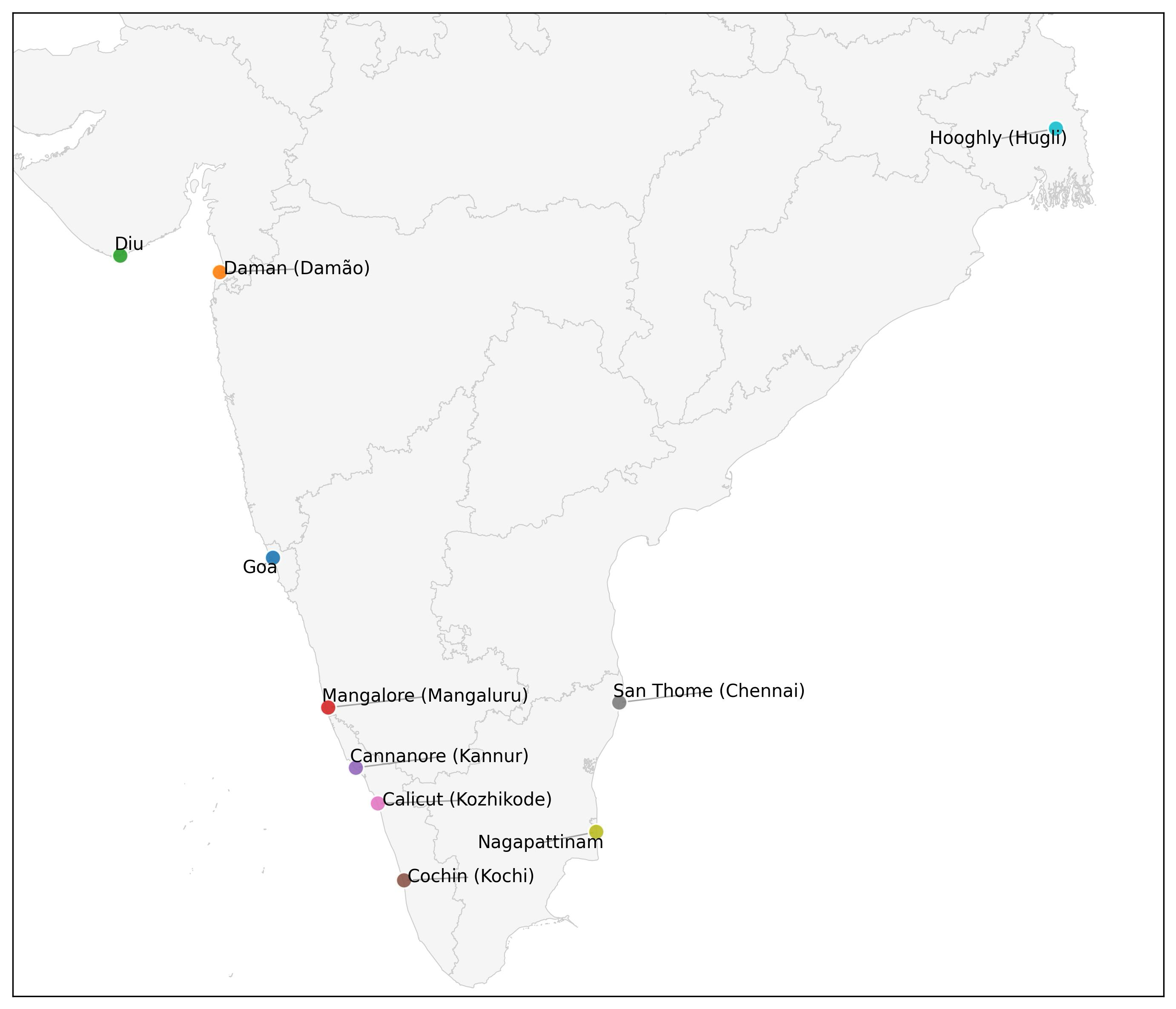
Portuguese Administration
- Viceroy as head with three-year term
- Vedor da Fazenda managed revenues and fleets
- Captains controlled fortresses with factors as assistants
Religious Policy
- Initially intolerant toward Muslims, tolerant toward Hindus
- Later persecuted Hindus after Inquisition in Goa
Lose Favour with the Mughals
- 1608: Captain William Hawkins reached Surat with letter from King James I
- Portuguese authorities failed to prevent Hawkins reaching Mughal court
- 1609: Jahangir gave Hawkins favorable reception, impressed by his Turki language skills; appointed Hawkins as mansabdar
- 1611: Hawkins left court, unable to counter Portuguese intrigues
- 1612: Battle of Swally: English ships Dragon and Osiander defeated Portuguese fleet, impressing Jahangir
- 1613: Portuguese captured Mughal ships, imprisoned Muslims, plundered cargo
- Shah Jahan permanently ended Portuguese court privileges
Capture of Hooghly
- 1579: Portuguese established trading post near Satgaon in Bengal, later monopolised salt/customs
- Portuguese conducted slave trade, seized Mumtaz Mahal's slave girls
- 1632: Shah Jahan ordered siege, captured Hooghly after three months
Reasons for decline of Portuguese
- 18th century: Portuguese lost commercial influence, some turned to piracy
- Powerful dynasties in Egypt/Persia/India
- Maratha expansion: 1739: Marathas captured Salsette and Bassein
- Religious conversion policies alienated locals
- Piracy and trade malpractices created hostility
- 1580-1581: Union with Spain dragged Portugal into Spain's wars
- Brazil discovery diverted colonising activities westward
Portuguese Legacy
- Introduced naval warfare with cannon to Indian Ocean
- Military innovations: infantry drilling system adopted by Indian armies
- Maritime technological advances: ship design, armaments
- Cultural contributions in silver work, architecture despite religious conflicts
- Crops introduced: Cashew nuts, Papaya, Pineapple, Chilies, Tomatoes and Potatoes.
Dutch
- Dutch rivalry with English (17th century) more bitter than with Portuguese
- Dutch East policy motivated by → revenge against Catholic Spain/Portugal, establishing East Indies monopoly
- First goal achieved through Portuguese decline, second led to English conflict
Dutch Settlements
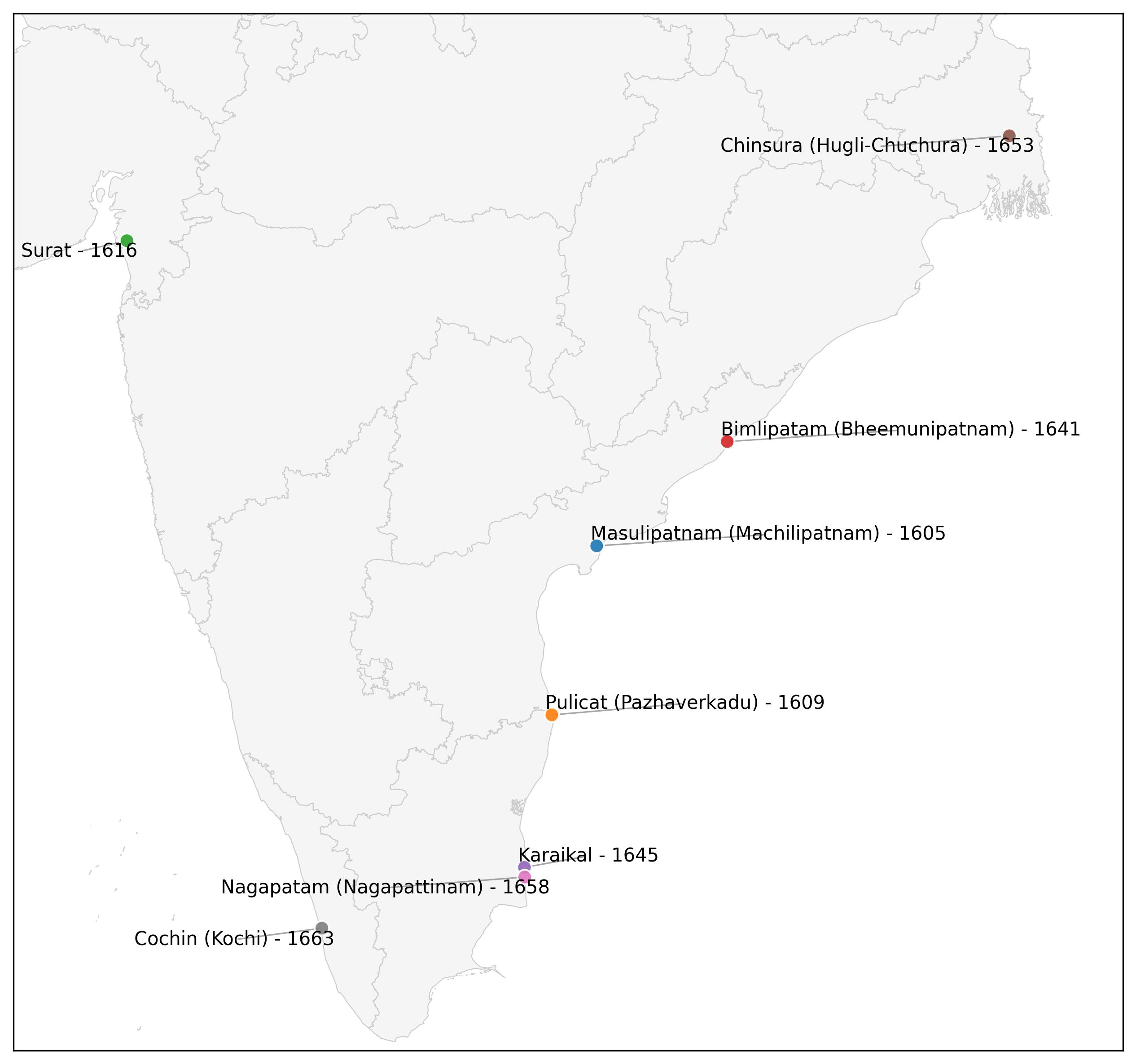
- Dutch captured Nagapatam from Portuguese, making it South India stronghold
- Dutch factories established across India
- 1605: First factory in Masulipatnam (Andhra)
- 1609: Pulicat (north of Madras)
- Other key factories: Surat (1616), Bimlipatam (1641), Karaikal (1645), Chinsura (1653), Nagapatam (1658), Cochin (1663)
- Dutch trade commodities
- Indigo (Yamuna valley)
- Textiles/Silk (Bengal, Gujarat, Coromandel)
- Saltpetre (Bihar)
- Opium/Rice (Ganga valley)
Anglo Dutch Rivalry
- Commercial competition evolved into warfare
- 1623: Amboyna Massacre (Dutch killed 10 Englishmen, 9 Japanese)
- 1667: Compromise reached - British withdrew Indonesia claims, Dutch focused on Indonesia
- Dutch monopolised black pepper and spices
Dutch Decline in India
-
Battle of Hooghly / Battle of Biderra / Battle of Chinsurah (1759 Bengal): English defeated Dutch, crushing their Indian ambitions
-
Third Anglo-Dutch War (1672-74) further weakened position
-
Dutch primarily interested in trade, not empire-building
-
Main commercial focus remained Indonesian Spice Islands
English
- 1600: Elizabeth I chartered East India Company with 15-year monopoly
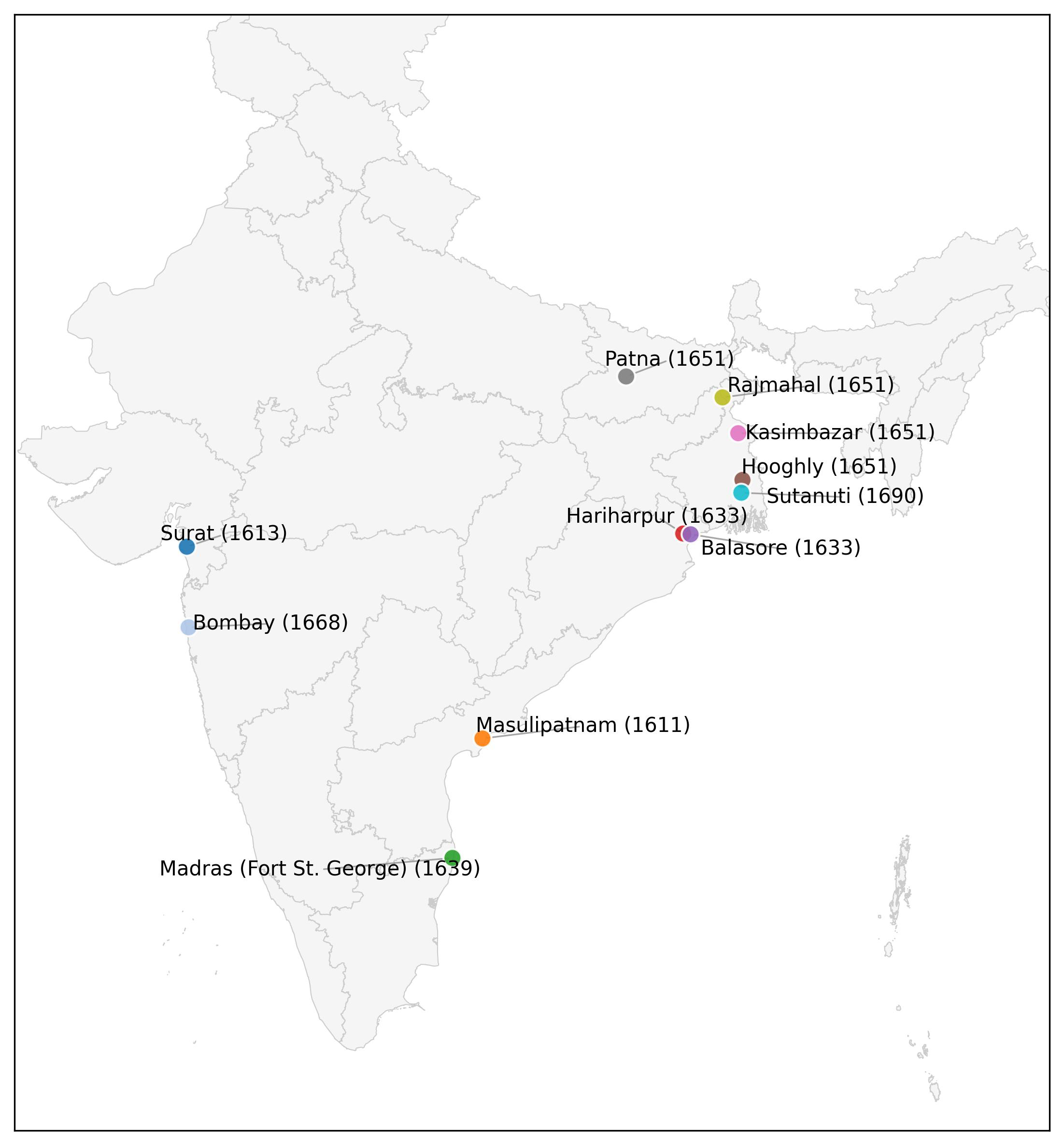
- West Coast → Surat, Bombay
- East coast → Madras, Masulipatnam → and then all clustered in WB
Progress of the English Company
- 1609: Captain Hawkins arrived at Jahangir's court but failed to establish Surat factory due to opposition from Portuguese
- 1611: English began trading at Masulipatnam, established factory by 1616
- 1612: Captain Thomas Best defeated Portuguese, impressing Jahangir
- 1613: Permission granted for factory at Surat, Agra, Ahmedabad, Broach (PYQ Modern History#Q1 2021)
- 1632: Golden Farman from Sultan of Golconda granted trading rights in the ports of Golconda for 500 pagodas yearly
- 1633: Factories established at Hariharpur and Balasore in eastern India
- 1639: Francis Day received permission from ruler of Chandragiri to build fortified factory at Madras (Fort St. George)
Foothold in Bengal
- 1651: Shah Shuja permitted English trade in Bengal for ₹3,000 annually
- Factories established at Hooghly, Kasimbazar, Patna, and Rajmahal
- 1682: William Hedges appealed to Shaista Khan over customs disputes
- 1686: Hooghly sacked by Mughals after hostilities erupted
- 1690: Job Charnock negotiated return to Sutanuti
- 1691: Imperial farman issued allowing continued trade
- 1698: English purchased zamindari rights to Sutanuti, Gobindapur, and Kalikata for ₹1,200
- & 1700: Fort William established as eastern presidency headquarters
Consolidation of Power
-
1662: Bombay received as dowry from Portuguese, transferred to Company in 1668
-
1687: Western Presidency headquarters moved from Surat to Bombay
-
1708: Rival companies merged to form 'United Company of Merchants of England Trading to the East Indies'
-
1717: Farrukhsiyar's farmans granted valuable privileges in Bengal, Gujarat and Hyderabad
- Company's Magna Carta
- Duty exemptions, permission to issue dastaks (passes) for transportation of goods, and currency recognition
-
This East India Company (1708-1873) established British political power in India
French
Foundation of French Centres in India
- French arrived late to Indian trade despite 16th century interest
- 1667: François Caron established factory in Surat
- 1669: Mercara founded factory in Masulipatnam with Sultan of Golconda's patent
- 1673: French obtained permission for Chandernagore township near Calcutta from Shaista Khan
- 1673-74: Pondicherry founded, became French stronghold under François Martin
- Additional factories established in Mahe, Karaikal, Balasore, Qasim Bazar
Early Setbacks
- Dutch-French war damaged French position
- 1693: Dutch captured Pondicherry
- 1697: Treaty of Ryswick restored Pondicherry to French
- War of Spanish Succession forced abandonment of factories in Surat, Masulipatnam, Bantam
Reorganisation and Revival
- 1720: Company reorganised as "Perpetual Company of Indies"
- Governors Lenoir and Dumas (1720-1742) enhanced French position
Anglo-French Struggle: Carnatic Wars
- Background: European trading powers drawn into Indian politics
First Carnatic War
- 1740-1748 Starts from 1740 → 8y
- Extension of Austrian War of Succession
- 1746: French seized Madras after English navy provoked France
- 1748: Treaty of Aix-La-Chapelle returned Madras to English
- Battle of St. Thome
- French vs Anwaruddin (Nawab of Carnatic)
- Eye opener for Europeans → Small disciplined army could defeat large Indian army
Second Carnatic War
- 1749-1754 +1 → 5y
- Dupleix exploited local succession disputes
- French supported Muzaffar Jang (Hyderabad) + Chanda Sahib (Carnatic)
- English backed Nasir Jang (Hyderabad) + Anwaruddin (Carnatic)
- 1749: Battle of Ambur (Chanda Sahib + Muzzafar Jang + French vs Anwaruddin) → Anwaruddin killed
- 1751: Robert Clive's capture of Arcot diverted Chanda Sahib
- 1752: Chanda Sahib executed after surrender
- 1754: Dupleix recalled, Godeheu (successor of Dupleix) negotiated treaty with English
- & Treaty established non-interference in local politics
- Demonstrated Indian authority's growing dependence on European support
Third Carnatic War
- 1758-1763 +4 → 5y
- Background: Part of Seven Years' War (1756-63) in Europe, Britain and France on opposite sides
- Course in India
- 1758: French initially captured English forts at St. David and Vizianagaram
- English became offensive, inflicted heavy losses on French fleet under D'Ache at Masulipatnam
- Battle of Wandiwash (January 22, 1760): Decisive English victory, English under Coote defeated French forces
- Outcome
- Pondicherry surrendered (1761), Treaty of Paris (1763) ended French political influence
- English became supreme European power in India with no rivals
Dupleix in India
- 1697-1754
- Administrative achievements: Balanced Pondicherry finances despite opposition, enhanced fortifications, established commercial emporium
- Diplomatic innovations: First European interfering in Indian politics, created subsidiary alliance system, placed French army in Hyderabad
- Downfall: Recalled 1754 after military defeats, company blamed financial losses on his policies
Cause of English Success and French Failure
| Factor | English | French |
|---|---|---|
| Company Structure | • Private enterprise • Operated with enthusiasm and self-confidence |
• State-controlled • Hampered by government policies and delays |
| Decision Making | • Made instant decisions • Operated independently without waiting for government approval |
• Required approval from France • Suffered from bureaucratic delays |
| Naval Power | • Superior navy • Could cut vital sea links between French possessions and France |
• Weaker naval presence • Vulnerable supply lines |
| Territorial Holdings | • Held three important places: Calcutta, Bombay, and Madras | • Primarily held only Pondicherry |
| Commercial Focus | • Maintained commercial interests • Better funds and financial condition |
• Subordinated commercial interests to territorial ambition • Suffered from fund shortages |
| Military Leadership | • Superior commanders including Eyre Coote, Stringer Lawrence, and Robert Clive | • Relied primarily on Dupleix • Lacked depth in military leadership |
| Native Relations | • Employed Indians as sepoys in their army | • Also employed Indians as sepoys • Neither side faced resistance based on national identity |
Why English Succeeded
- Corporate structure: Shareholder-controlled English company vs state-run French company with guaranteed dividends
- Naval dominance: Advanced fleet with superior mobility (most advanced but not largest) defeated Portuguese and French forces
- Military advantages: Disciplined soldiers, strategic commanders, technological superiority enabled smaller forces to defeat larger armies
- Economic foundations: Early Industrial Revolution (textiles, metallurgy, steam power) created production advantages
- Political stability: Consistent governance vs French revolution, Napoleonic wars, Dutch bankruptcy
- Financial innovation: Debt market utilisation through Bank of England funded military campaigns
- Cultural approach: Less religious zealotry made British rule more acceptable to Indian subjects
4. India on the Eve of British Conquest
Decline of Mughal Empire (18th century)
- Aurangzeb's reign (1658-1707) marked beginning of Mughal decline
- Aurangzeb's misguided policies weakened state stability
- Post-Aurangzeb decline accelerated due to succession wars and weak rulers
Mughal Rulers after Aurangzeb
Jahandar Shah initiated Jizya abolition but Farrukhsiyar was the one under whose reign it was implemented
| Emperor | Years | Remarks |
|---|---|---|
| Bahadur Shah I | 1707-12 | • Pacifist policy with Marathas, Rajputs, Jats, Shahu |
| Jahandar Shah | 1712-13 | • Introduced izara system for financial improvement • Abolished jizya |
| Farrukhsiyar | 1713-1719 | • Religious tolerance → Abolished jizya, pilgrimage tax • First emperor killed by nobles |
| Rafi-ud-Daula | June 6-Sep 17, 1719 | • Opium addict • Placed by Sayyid brothers |
| Muhammad Shah | 1719-48 | • Known as Rangeela (luxurious lifestyle) • Defeated by Nadir Shah at Battle of Karnal (1739) |
| Ahmad Shah Bahadur | 1748-1754 | • Incompetent • Left affairs to Udham Bai |
| Alamgir II | 1754-59 | • Battle of Plassey (1757) under his reign • Assassinated |
| Shah Jahan III | 1759-60 | • Deposed through Maratha intervention |
| Shah Alam II | 1760-1788, 1788-1806 | • Faced Third Panipat (1761) • Faced Battle of Buxar (1764) • Issued perpetual farman to British of Diwani of Bengal, Bihar, Orissa |
| Akbar Shah II | 1806-37 | • Gave "Raja" title to Rammohan Roy • East India Company stopped calling itself subject of Mughal emperor |
| Bahadur Shah II | 1837-57 | • Last Mughal emperor • Led 1857 Revolt • Captured and exiled to Rangoon |
External Challenges to Mughals
- Weak borders allowed northwestern invasions
- Nadir Shah (Persian) invaded 1738-1739, defeated Mughals at Karnal, looted Delhi
- Ahmad Shah Abdali (Afghan) invaded multiple times (1748-1767)
- Chapter 3 - 5#^Third-Battle-of-Panipat
- Battles at Panipat
- First Battle (1526): Babur vs Ibrahim Lodhi, established Mughal Empire
- Second Battle (1556): Akbar vs Hemu, continued Mughal rule
- Third Battle (1761): Marathas vs Ahmad Shah Abdali, ended Maratha ambitions of ruling over India
- Strategic location: Accessible battlefield near Delhi, flat ground suitable for warfare, enroute Grand Trunk Road, short monsoon, availability of artisans / smiths for warfare materials
Cause of Decline of Mughal Empire
- Two Views on Mughal Decline
- Empire-related: Internal structural weaknesses
- Region-related: Regional instability and turmoil
- Accelerated after Aurangzeb's death (1707)
Major Factors Contributing to Decline
- Shifting Allegiance of Zamindars
- Zamindars: hereditary landowners (rais, rajas, thakurs, khuts, desmukhs) with revenue collection role
- Maintained soldiers, occupied important administrative position
- During Aurangzeb's reign, power of zamindars increased significantly
- Local zamindars helped nobility exploit empire weakness, carved independent kingdoms
- Jagirdari Crisis
- Nobility comprised jagirdars (assigned lands) and mansabdars (appointed administrators)
- Divisiveness among nobility based on religion, homeland, tribe
- Mutual rivalry, jealousy, power contests reduced empire prestige
- Rise of Regional Aspirations
- Aurangzeb's reign: rebellions by Jats, Sikhs, Marathas seeking own kingdoms
- Their continuous struggle weakened empire considerably
- Aurangzeb and Bahadur Shah I's attempts to suppress Rajputs backfired
- Marathas expanded from Maharashtra to collecting sardeshmukhi and chauth throughout India
- By 1740, Marathas controlled Gujarat, Malwa, Bundelkhand
Scholarly Perspectives on Decline
- Satish Chandra: Medieval economic stagnation, trade/industry decline, scientific underdevelopment, nobility's factional struggles
- Irfan Habib: Economic and administrative causes, not religious reaction
- William Irvine: Military inefficiency as principal cause
- Sidney Owen: Aurangzeb's policies (reimposing jizya), alienating Hindu subjects
- J.N. Sarkar: "Rottenness at core" - military/political helplessness, corrupt nobles
Rise of Regional States
- Three categories of states emerged after Mughal Empire's decline
- Successor States
- Mughal provinces that broke away
- Maintained Mughal ruler's sovereignty while establishing hereditary authority
- Examples: Awadh, Bengal, Hyderabad
- Independent Kingdoms
- States formed through destabilisation of Mughal control
- Examples: Mysore and Rajput states
- New States
- Established by rebels against Mughal empire
- Examples: Maratha, Sikh, Jat states
Major Regional Powers
| Region | Type | Founder/Key Ruler | Time Period | Notable Achievements/Events |
|---|---|---|---|---|
| Sikhs | Rebel | Guru Gobind Singh | Late 17th century | Transformed into militant sect under Guru Gobind Singh |
| Ranjit Singh | Late 18th-Early 19th century | Ranjit Singh built strong Punjab kingdom (1799-1839) | ||
| Marathas | Rebel | Peshwas | Mid 18th century | • Most formidable province under Peshwas • Challenged by Afghans at Chapter 3 - 5#^Third-Battle-of-Panipat |
| Jats | Rebel | Suraj Mal | Mid 18th century (until 1763) | • Agricultural settlers who revolted against Mughals • Established efficient administration under Suraj Mal |
| Hyderabad | Successor | Kilich Khan (Nizam-ul-Mulk) | 1724-1725 | • Kilich Khan defeated Mubariz Khan at Battle of Shakr-Kheda (1724) • Became Deccan viceroy (1725) |
| Bengal | Successor | Chapter 3 - 5#^Murshid-Quli-Khan | Early 18th century | • Created prosperous state • Succeeded by Shuja-ud-din (1727) • Later ruled by Alivardi Khan (1740) |
| Awadh | Successor | Saadat Khan | Early 18th century | • Established the state • Later succeeded by Safdar Jang |
| Mysore | Independent | Haidar Ali | Mid 18th century | • At junction of Western and Eastern Ghats • Rose to prominence under Haidar Ali |
| Rajputs | Independent | • Ajit singh • Jai Singh II • Durgadas Rathor |
18th century | • Attempted independence • Temporarily controlled territory from Delhi to western coast |
| Rohilkhand | Ali Muhammad Khan | Early-Mid 18th century | Established following Afghan migration | |
| Kerala | Martanda Varma | • Boundaries extended from Kanyakumari to Cochin • Developed army along western model |
Types of Regional Powers
- Successor States: Former Mughal provinces establishing independent hereditary authority without challenging Mughal sovereignty
- Independent Kingdoms: States declaring independence during Mughal control destabilisation, previously having considerable autonomy
- Rebel States: Established by rebels against Mughal empire
Nature of Regional States
- Political Characteristics
- Provincial systems recognized Mughal emperor as supreme authority
- Functioned with local elite (zamindars, merchants, chieftains) support but lacked sound administration
- Limitations and Challenges
- Failed to develop sound financial/administrative/military systems
- Backward in science and technology
- Constant warfare with neighboring powers, none could dominate
- Strong enough to challenge Mughal power but unable to establish all-India polity
- Economic Factors
- Jagirdari crisis intensified as agricultural income declined
- Contenders for power multiplied
- Foreign trade prospered while rest of economy stagnated
Socio Economic Conditions in 18th-century India
Economic Contrasts
- Extreme wealth-poverty contrast; masses better off than under later British rule
- Self-sufficient in handicrafts/agriculture with favorable trade balance → known as Sink of Precious Metals
- Major exports
- Cotton textiles, raw silk, silk fabrics
- Hardware
- Opium, Indigo, Saltpetre
- Rice, wheat, sugar, pepper, other spices
- Precious stones
- Drugs
- Imports
- Persian Gulf: pearls, silk, wool, dates, dried fruits, rose water
- Arabia: coffee, gold, drugs, honey
- China: tea, sugar, porcelain, silk
- Tibet: gold, musk, woollen cloth
- Africa: ivory, drugs
- Europe: woollen cloth, metals (copper, iron, lead), paper
Agricultural System
- Agriculture sustained society despite technical backwardness
- Peasants exploited by state, zamindars, jagirdars
Manufacturing and Trade
- Shipbuilding flourished in coastal regions, Leading regions: Maharashtra, Andhra, Bengal
- Self-sufficient handicraft production
Education
- Traditional system lagging behind West; focused on literature, law, religion, philosophy
- Elementary education in pathshalas (Hindu) and maktabs (Muslim); limited to basics
- Higher education in Chatuspathis/Tols
- Sanskrit education centers → Kasi (Varanasi), Tirhut (Mithila), Nadia, Utkala
- Madrasahs taught Persian/Arabic; Azimabad (Patna) was Persian education center
Social Structure
- Society showed cultural unity yet divided by caste, religion, region, language
- Hindu varnas and sub-castes determined social position and profession
- Muslims divided between sharif (nobles, scholars) and ajlaf (lower-class)
- Panchayats enforced caste regulations; conversions occurred but caste remained divisive
Women's Status
- Patriarchal system restricted women's freedom; upper-class homebound, lower-class worked
- Oppressive practices: purdah, sati, child marriage, dowry, polygamy
- Widow conditions especially harsh; reform attempts for widow remarriage failed
Slavery
- Economic distress drove people to sell offspring; domestic slavery common
- Indian slaves treated better than European counterparts; could marry; offsprings were free
- European arrival intensified slave trade to American/European markets
Cultural Developments
- Talented artists sought patronage at new state courts (Hyderabad, Lucknow, Jaipur, Murshidabad, Patna, Kashmir)
- Notable constructions: Bara Imambara (Lucknow, 1784), Jaipur pink city, five astronomical observatories by Sawai Jai Singh
- Jai Singh created Zij Muhammad-shahi astronomical timetables
- Painting: Rajputana and Kangra schools gained prominence
- Literature: Urdu growth produced poets Mir, Sauda, Nazir, Ghalib; Malayalam flourished under Travancore; Tamil enriched by sittar poetry
- Major works: Heer Ranjha (Punjabi) by Waris Shah, Risalo (Sindhi) by Shah Abdul Latif
5. Expansion and Consolidation of British Power in India
British Imperial History
- Divided into two phases
- First empire: Atlantic-focused (America, West Indies)
- Second empire: Post-1783 (Peace of Paris), East-focused (Asia, Africa)
Debate on British Conquest
- Two opposing schools
- Accidental conquest theory → British came to trade without territorial ambitions
- Intentional conquest theory → British had clear plan to establish empire
- Motivating factors → quick profits, personal ambitions, rivalries, political developments in Europe
- 1798-1818 → British motives became consciously imperialistic
British Period in India Timeline Debates
- Various proposed starting points
- 1740: Anglo-French struggle
- 1757: Battle of Plassey
- 1761: Third Battle of Panipat
- Political transformation took approximately 80 years
Causes of British Success in India
- Superior military technology: muskets and cannons with better speed and range
- Better military discipline and regular salary system ensuring loyalty
- Civil discipline and fair selection system based on reliability and skill
- Brilliant leadership (Clive, Hastings, Wellesley) with strong second-line leaders
- Strong financial backing from Company's trade profits
- Nationalist pride contrasting with divided Indian political landscape
British Conquest of Bengal
Bengal on the Eve of British Conquest
-
Richest Mughal province including present Bangladesh, Bihar, Odisha
-
Exports → saltpetre, rice, indigo, pepper, sugar, silk, cotton textiles
-
English East India Company established factories in Balasore, Hooghly, Kasimbazar, Patna, Dacca (1690s)
-
1699 - 1727: Murshid Quli Khan → Bengal's Dewan
-
1727 - 1756: Alivardi Khan ruled, stopped Mughal tributes
- Alivardi Khan ruled 15 years, fought Marathas, allowed English entrenchment
- Died April 1756, succeeded by grandson Siraj-ud-Daulah
-
Siraj-ud-Daulah → Young ruler (20) with rival factions in court + Faced threats from English commercial expansion
Battle of Plassey
- Company misused trade privileges, affecting nawab's finances
- Siraj attacked English at Calcutta
- Robert Clive formed secret alliance with Mir Jafar
- Battle fought June 23, 1757 → Siraj's 50,000 troops defeated by Clive's small force
Significance of Battle of Plassey
- Outcome: Mir Jafar became Bengal Nawab, granted English money and 24 parganas
- Significance: Established British rule, military supremacy in Bengal, ousted French
- Power dynamics: Control to Clive, Jafar dependent on English support
Plassey Plunder
- Immediately after the war, the English army and navy received £275,000 each.
- Between 1757 and 1760, the Company received ₹22.5 million from Mir Jafar, and Clive himself got a personal jagir worth £34,567 in 1759
- Mir Jafar was not able to satisfy the financial demands of Clive
Mir Kasim who also failed
Mir Kasim and Treaty of 1760
- Mir Jafar irritated by Clive's interference, conspired with Dutch
- 1759: Dutch defeated at Bedara / Biderra (Chapter 3 - 5#^Battle-Of-Hooghly)
- Jafar's treachery and payment failures annoyed English
- Treaty terms
- Company received Burdwan, Midnapur, Chittagong districts
- Company got half share in Sylhet chunam trade
- Mir Kasim to pay outstanding dues, ₹ 5L for southern India wars
- Mutual enemies/friends agreement, no tenant settlement in each other's lands
- Mir Jafar resigned in favour of Mir Kasim
Mir Kasim's Initiatives
- Shifted capital to Munger (away from Calcutta)
- Reorganised administration and army
Battle of Buxar
- Prelude
- Mir Kasim defied Company's puppet ruler expectations
- Tensions from
- Company's dastak misuse
- Duty exemptions → Mir Kasim wanted to abolish duties altogether; British demanded preferential treatment
- Unfair trade practices
- Mir Kasim fled to Awadh, allied with Nawab of Awadh (Shuja-ud-Daulah) and Mughal Emperor (Shah Alam II)
- The Battle
- 1764: Combined armies of Mir Kasim, Nawab of Awadh, Shah Alam II defeated by English forces (led by Hector Munro) at Buxar
- & Battle significance: Not just Nawab but Mughal Emperor defeated
- Victory established English as major power in northern India
Treaty of Allahabad 1765
- Robert Clive concluded treaties with Nawab of Awadh and Mughal Emperor
- Nawab Shuja-ud-Daula agreed to:
- Surrender Allahabad and Kara to Shah Alam II
- Pay ₹50 lakh war indemnity
- Give Balwant Singh full possession of Banaras estate
- Shah Alam II agreed to
- Reside at Allahabad under Company protection
- Issue farman granting diwani of Bengal, Bihar, Orissa
- Clive avoided annexing Awadh to create buffer state
- Emperor's farman legalised Company's political gains in Bengal
- Mir Kasim died in poverty (1777)
Dual Government in Bengal (1765-72)
-
Company became real masters of Bengal
-
& Dual system
- Company controlled diwani (revenue collection and control over civil justice). Appointed Naib Diwan to exercise these functions on its behalf
- Nawab controlled nizamat (police) (🧠 N controls N i.e Nawab controls Nizamat)
-
System advantaged Company: Puppet ruler facade maintained while Company held real power
-
1772:
- System led to administrative breakdown
- British#Warren Hastings (1772-1785) abolished dual system
Mysore's Resistance to the Company
- 1565: The Wodevar/Mysore Dynasty emerged after Vijayanagara's fall
- 1612: Hindu Wodevar kingdom established in Mysore region
- Late 18th century: Mysore became formidable under Haidar Ali and Tipu Sultan
- English threatened by Mysore's French alliance and control of Malabar Coast trade
- Mysore threatened English control of Madras
Rise of Haidar Ali
- Rose from horseman to ruler (1761)
- Modernised army with French help → Established arms factory at Dindigul (TN)
- Captured territories (1761-63), defeated Poligars
- Lost to Marathas (1764-71) but recovered territories (1774-76)
Anglo Mysore Wars
First Anglo-Mysore War (1767-69)
- Background: British confidence after Bengal success led to treaty with Nizam of Hyderabad (1766), acquiring Northern Circars (coastal Andhra Pradesh) Start in 1767; 2Y
- Haidar Ali's existing disputes with Nawab of Arcot and Marathas complicated regional politics
- Initial alliance of British, Nizam, and Marathas against Haidar collapsed when Haidar diplomatically turned Marathas neutral and Nizam into ally
- War continued inconclusively for 18 months until Haidar's strategic move to Madras gates created panic
- Treaty of Madras (April 1769): Humiliating for British, Both sides restored territories captured during war, Defensive clause → Both parties agreed to help each other
- Mysore pioneered military rocket technology under Hyder Ali and Tipu Sultan
- Iron cased rockets that could travel upto 2 km were used against EIC
- After Tipu Sultan defeat British took Mysore rocket specimens to England
Second Anglo-Mysore War (1780-84)
- Background +11Y, 4Y
- 1771: British violated Treaty of Madras by not supporting Haidar when attacked by Marathas
- Haidar found French more reliable allies; American Revolution made French-Indian alliances concerning to British
- British attempt to capture French-held Mahe (Malabar Coast, Kerala) triggered Haidar's response as violation of his sovereignty
- 1781
- Haidar formed coalition with Marathas and Nizam, defeated British under Colonel Baillie
- English regrouped, detached Marathas and Nizam from Haidar's side, defeated Haidar at Porto Novo (modern day Parangipettai, coastal town in TN)
- 1782: Haidar died in December; Tipu Sultan continued war for another year without decisive outcome
- 1784: Treaty of Mangalore signed in March, both sides returned to pre-war territorial status quo
Third Anglo-Mysore War (1790-92)
+6Y, 2Y
- 1790: Tipu declared war in April against Travancore (British ally) over territorial rights dispute
- 1790: Initial British campaign → unsuccessful
- 1791: British#Lord Cornwallis (1786-1793, 1805) personally took command, captured Bangalore and advanced toward Seringapatam
- British forces, supported by Marathas and Nizam, twice threatened Seringapatam
- 1792: Treaty of Seringapatam forced Tipu to surrender half his territories, pay substantial indemnity of ₹ 3 crore
- Tipu's sons taken as hostages until initial payment made; remaining amount to be paid in instalments
Fourth Anglo-Mysore War (1799)
+7Y
- 1792-1799: Recovery period for both sides; Tipu fulfilled treaty terms and secured sons' release
- 1796: Tipu declared himself sultan after Wodeyar's death, sought to avenge earlier defeat
- 1798: Lord Wellesley became governor-general, grew concerned about Tipu's French connections
- British accused Tipu of plotting with regional powers and sending emissaries to foreign nations
- 1799: War lasted from April 17 to May 4, ended with fall of Seringapatam and Tipu's death in battle
- Mysore dismembered: territories distributed among British, Marathas, and Nizam
- Wodeyar dynasty restored under British subsidiary alliance system
- Multilingual ruler, "Tiger of Mysore"
- Modernised military: European structure, Persian commands, French trainers
- 1796: Naval expansion plan → 42 warships, three dockyards → plans did not fructify
- Technology pioneer: rocket development, sericulture introduction
- Demolished temples in Kerala
- 1797: Embraced democratic ideals → Jacobin Club member "Citizen Tipu"
- Economic reformer: opposed feudalism, promoted capitalism
Anglo Maratha Struggle for Supremacy
Rise of the Marathas
- Marathas gained power as Mughal Empire declined, controlling large portions of country
- By mid-18th century, aspired to rule North Indian empire and influenced Mughal court
- Third Battle of Panipat (1761): Defeated by Ahmad Shah Abdali, but regrouped within a decade
- Bajirao I (1720-1740): Greatest of all Peshwas, Created confederacy of prominent Maratha chiefs
- Maratha confederacy structure: Each family assigned sphere of influence under senapati
- Prominent families
- Gaekwad (Baroda)
- Bhonsle (Nagpur)
- Holkars (Indore)
- Sindhias (Gwalior)
- Peshwa (Poona)
- Madhavrao I's death in 1772 weakened Peshwa control over confederacy
- First Anglo-Maratha War (1775-82): Chiefs united against British but often quarrelled
Entry of the English Into Maratha Politics
- Three clashes between Marathas and English (late 18th-early 19th century)
- English victory due to inordinate ambition and divided Maratha leadership
- English in Bombay sought government like Clive's in Bengal
- Succession disputes provided opportunity for English intervention
First Anglo-Maratha War (1775-1782)
-
Background 1775; 7Y
- 1772: Narayanrao succeeded Madhavrao, assassinated by uncle Raghunathrao
- 1774: Sawai Madhavrao born posthumously, Barbhai (12 Maratha chiefs) council formed regency under Nana Phadnavis to rule as regents for Sawai Madhavrao
-
Treaties of Surat and Purandhar
-
1775: Raghunathrao sought English help, signed Treaty of Surat
- Treaty ceded territories of Salsette and Bassein to English with revenue portion
- English promised 2,500 soldiers to Raghunathrao
- British Calcutta Council condemned Treaty of Surat, sent Colonel Upton to Pune
-
1776: Treaty of Purandhar annulled Surat treaty, denounced Raghunathrao
-
1777: Nana Phadnavis violated Calcutta Council agreement by granting French port
-
English retaliated by sending force toward Pune
-
-
Course of War
-
Marathas outnumbered English but faced ammunition disadvantage
-
Mahadji Scindia trapped English in mountain passes near Talegaon
-
Scorched earth tactics cut English food/water supplies
-
1779: Surrounded English surrendered, signed Treaty of Wadgaon
-
Treaty reversed all English territorial gains since 1775
-
-
Treaty of Salbai (1782)
- British#Warren Hastings (1772-1785) rejected Chapter 3 - 5#^Treaty-Of-Wadgaon, recaptured Ahmednagar, Bassein
- Feb 1781: English under General Camac defeated Scindia at Sipri
- 1782: Treaty of Salbai signed
- Key provisions
- Salsette remains with English
- Territories conquered since Purandhar returned to Marathas
- Fateh Singh Gaekwad maintains pre-war territory
- No English support for Raghunathrao
- Haidar Ali returns territory taken from English
- Peshwa not to support other European nations
Second Anglo-Maratha War (1803-1805)
-
Background +21; 2Y
- 1795: Bajirao II became Peshwa after Madhavrao Narayan's (→ Chapter 3 - 5#^Sawai-Madhavrao) suicide
- 1800: Nana Phadnavis's death created power vacuum
-
Course of War
- 1801: Peshwa (Bajirao II) murdered Jaswantrao Holkar's brother
- 1802
- Jaswant defeated combined armies of Scindia and Bajirao II
- Bajirao II fled to Bassein, signed treaty with English
-
Treaty of Bassein (1802)
- Peshwa accepted 6,000 British troops with artillery in his territories
- Ceded territories yielding ₹26 lakh income
- Surrendered Surat, gave up claims on Nizam's dominions
- Accepted Company's arbitration in disputes with Nizam/Gaekwad
- No Europeans of nations at war with English in employment
- Relations with other states subject to English control
-
Reduced to Vassalage
- Scindia and Bhonsle attempted to save Maratha independence
- Resistance crushed by Wellesley
-
1803
- Treaty of Deogaon (Bhonsle)
- Treaty of Surji-Anjangaon (Scindia)
-
1806: Treaty of Rajpurghat with Holkar
-
British gained strategic military positions across Maratha territory, establishing foundation for Indian control
Third Anglo-Maratha War (1817-1819)
- Background +12, 2Y
- 1813: Charter Act ended Company's China trade monopoly, creating market needs
- Unemployed Pindari mercenaries began plundering Company territories
- Marathas viewed anti-Pindari actions as sovereignty violation
- 1817: Bajirao II rallied Maratha chiefs against British
- War Events
- Peshwa, Appa Sahib, Holkar attacked British positions
- Marathas weakened by administrative inefficiency
- British prevented Peshwa from uniting confederacy
- Results
- Peshwa defeated at Khirki, Bhonsle at Sitabuldi, Holkar at Mahidpur
- Treaties signed
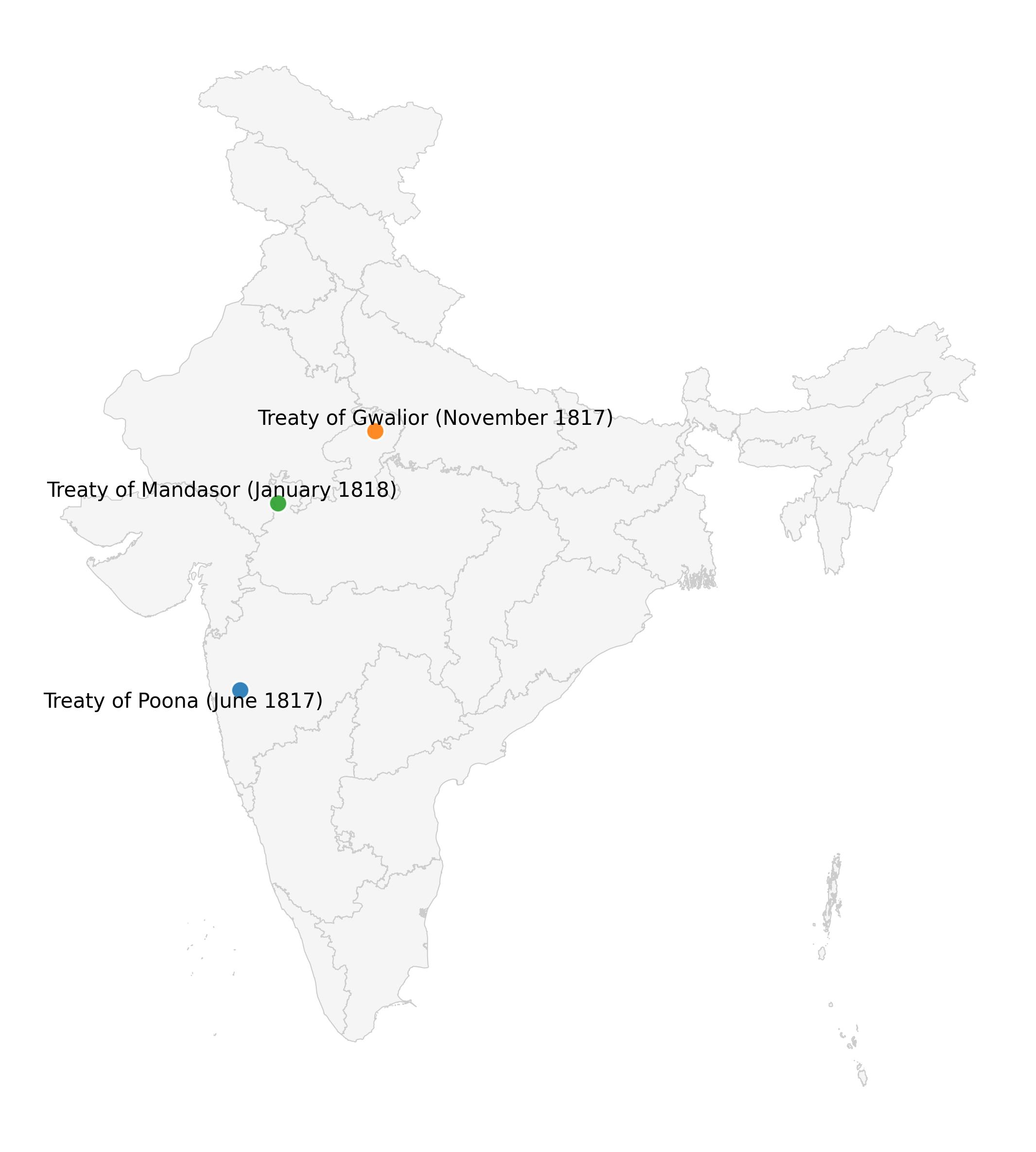
- 1817
- Peshwa → Treaty of Poona
- Scindia → Treaty of Gwalior
- 1818
- Holkar → Treaty of Mandasor
- Peshwa surrendered, confederacy dissolved
- Peshwaship abolished, Bajirao II became British retainer
Maratha Defeat Factors
- Inept Leadership: Maratha state despotic, later Maratha leaders (Bajirao II, Daulatrao Scindia, Jaswantrao Holkar) worthless compared to English officials
- Defective Nature of Maratha State: Cohesion not organic but artificial, no well-thought organization or unification
- Loose Political Set-up: Loose confederation under Chhatrapati then Peshwa, powerful chiefs carved semi-independent kingdoms
- Inferior Military System: Marathas inferior in organization, weaponry, discipline, leadership
- Unstable Economic Policy: No stable economy, industries or foreign trade
- Superior English Diplomacy: English better at finding allies and isolating enemies
- Progressive English Outlook: English rejuvenated by Renaissance and scientific innovations while Marathas remained in medievalism
- & English attacked a "divided house" that crumbled after a few pushes
Conquest of Sindh
- Early 19th century: English showed interest in Sindh, enjoyed trade facilities authorized by Mughal Emperor's farman (1630)
- Farman provided English privileges in Sindh ports, enjoyed elsewhere
Rise of Talpuras Amirs
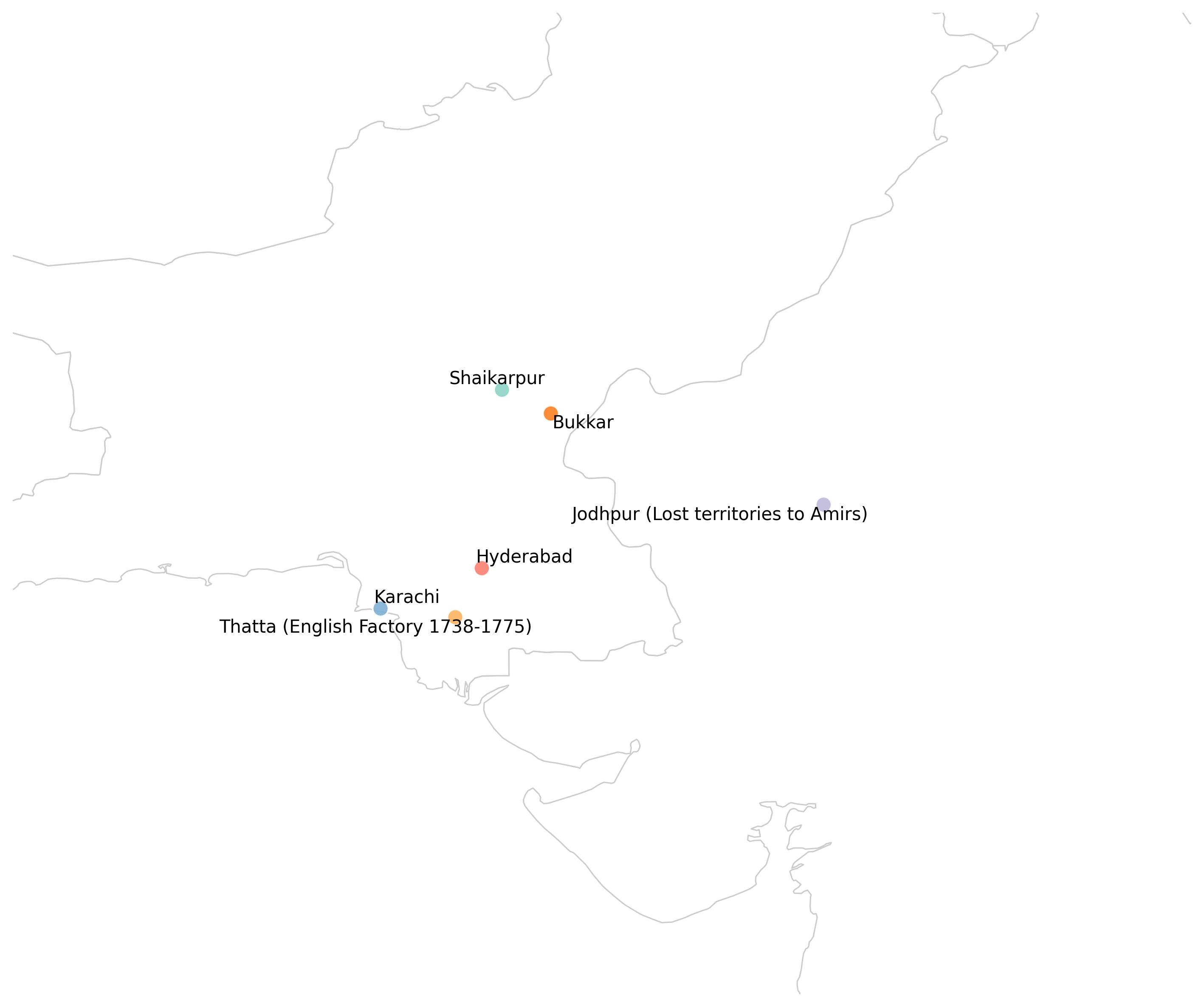
- 18th century: Kallora chiefs ruled Sindh
- 1738-1775: English factory at Thatta established via Ghulam Shah's parwana, closed by Sarfraz Khan
- 1770s-1783: Talpuras (Baluch tribe) → excellent soldiers → established control under Mir Fath Ali Khan
- 1799: Durrani monarch confirmed Mir Fath's claims
- 1800: Char Yar divided kingdom among brothers after Mir Fath's death
- Amirs conquered territories from Jodhpur Raja, acquired Karachi, Shaikarpur, Bukkar
Gradual Ascendancy over Sindh
- Late 18th century belief: Napoleon conspiring with Tipu Sultan against India
- Lord Wellesley revived commercial relations to counter French - Tipu - Shah Zaman alliance
- 1800
- Negotiations with Fath Ali Khan failed due to Tipu's influence and local traders' jealousy
- British agent ordered to quit Sindh within ten days
- British Company quietly suffered insult
Treaty of Eternal Friendship 1809
- Napoleon's Tilsit alliance with Alexander I threatened India invasion
- British sent delegations to Lahore, Kabul, Tehran seeking alliances
- & Amirs agreed to treaty → First every treaty with English
- Both sides excluded French from Sindh, exchanged agents
- 1820: Treaty renewed, excluded Americans
Treaty of 1832
- Bentinck sent Pottinger (political agent) to secure Sindh-Amirs treaty
- English gained trade passage rights through Sindh/Indus
- Restrictions: no warships, no settlement, passports required
- Amirs retained tariff control, no military tolls imposed
- Joint Amirs - Jodhpur action against Kachch robbers
- Previous treaties reaffirmed with mutual respect clause
Lord Auckland and Sindh
- 1836
- Lord Auckland became Governor General, viewed Sindh as buffer against Russian invasion
- Ranjit Singh captured Rojhan (Punjab, Pakistan), British signed new treaty with Amirs offering protection against Ranjit Singh
- Company troops stationed in capital at Amir's expense or concessions to English
- 1838
- Amirs signed treaty allowing British intervention, resident presence
- Sindh became protectorate
Tripartite Treaty of 1838
- British persuaded Ranjit Singh to sign tripartite treaty allowing British mediation with Amirs
- Emperor Shah Shuja surrendered sovereign rights on Sindh for tribute payment
Sindh Accepts Subsidiary Alliance 1839
- Amirs accepted Subsidiary Alliance under threat of superior force
- Overturned 1832 ban on English troop movement
- Amirs paid Rs 3 lakh annually for British forces at Shikarpur/Bukkar
- Required Karachi storage facility, Indus toll abolition
- Restricted foreign diplomacy, mandated military support for Afghan campaign
Capitulation of Sindh
- 1839-1842: Sindh forced to host unpopular First Anglo-Afghan War
- Amirs falsely accused of treason despite treaty compliance
- New treaty demanded provincial cession, steamer fuel, end to coin minting
- 1843: British exploited succession dispute, crushed revolt
- Amirs exiled, Sindh annexed under Charles Napier's governorship
Criticisms of the Conquest
- Historians condemn British acquisition of Sindh as deliberately manufactured
- English annexed Sindh to compensate for prestige loss in First Afghan War
Conquest of Punjab
Consolidation of Punjab under Sikhs
- After Guru Gobind Singh's death, Sikhs divided into Bandai (Liberal) and Tat Khalsa (Orthodox)
- 1721: Rift ended under Bhai Mani Singh's influence
- 1784: Kapur Singh Faizullapuria organized Sikhs under Dal Khalsa. Divided into
- Buddha Dal: Veterans
- Taruna Dal: Youth
- 1763-1773: Misls (democratic military brotherhoods) emerged during Mughal decline
- Area under rule
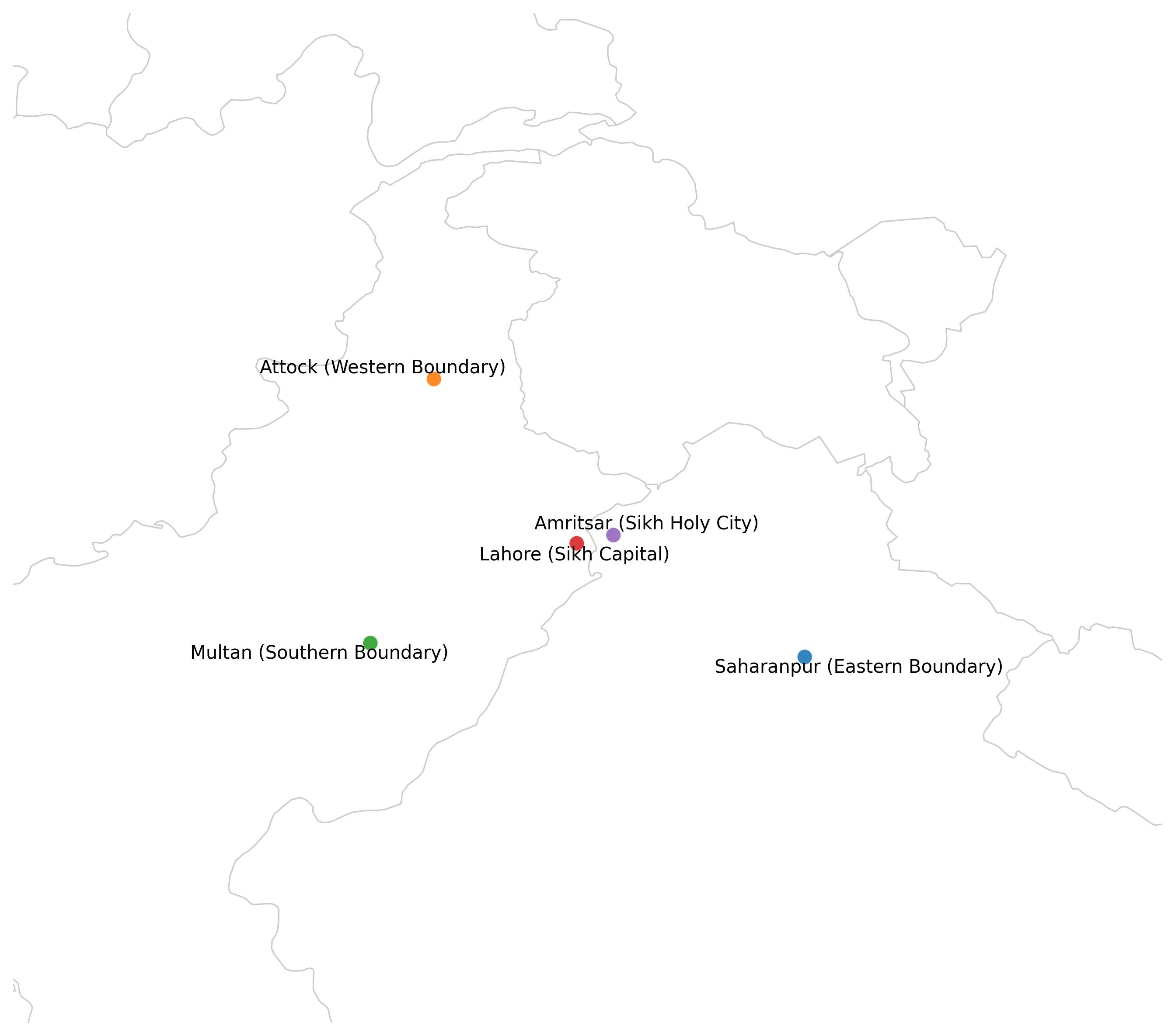
- East: Saharanpur
- West: Attock
- North: Mountains
- South: Multan
- Area under rule
Maharaja Ranjit Singh
- 1780: Ranjit Singh born, inherited Sukarchakiya misl at age 12, followed policy of Blood and Iron
- 1799: Appointed Lahore governor by Afghan ruler
- 1805: Acquired Jammu and Kashmir, Controlled both Lahore and Amritsar, establishing Punjab dominance
Ranjit Singh and the English
- 1807
- Metcalfe mission to Lahore; Singh offered alliance if English remained neutral in Sikh-Afghan conflicts
- Ranjit sought recognition as Punjab sovereign; Negotiations failed as political scenario changed
- 1809: Treaty of Amritsar signed as Napoleonic threat receded
Treaty of Amritsar Significance
- Checked Ranjit Singh's ambition to extend rule over entire Sikh nation
- Established Sutlej river as boundary for his dominions
- Redirected his energies westward: captured Multan (1818), Kashmir (1819), Peshawar (1834)
- 1838: Political compulsions forced Tripartite Treaty with English
- Granted British army passage through territories to attack Dost Muhammad
Ranjit Singh's Relations with Company (1809-1839)
- Showed former's weak position
- Failed to organize coalition of Indian princes or maintain power balance
- Died June 1839, beginning empire's decline
Punjab after Ranjit Singh
- 1839: Kharak Singh's (son of Ranjit Singh) ineffective reign ended with his death; heir Nau Nihal Singh died same day
- Court factions created anarchy; Sikh army weakened by dead generals, unpaid troops, poor officers
- British troops allowed passage through Punjab, causing economic disruption (passage strained economic resources)
- Succession crisis: Sher Singh murdered (1843), minor Dalip Singh installed with regents
- 1844-1845: Rapid turnover of ministers through murder/execution (Hira Singh Dogra, Jawahar Singh)
- Lal Singh became wazir, Teja Singh army commander
First Anglo-Sikh War (1845-46)
- Causes: Sikh army crossing River Sutlej (December 11, 1845), providing British justification to declare war
- Course of War
- Began December 1845, British (20k-30k troops) versus Sikhs (50k troops under Lal Singh)
- Lal Singh and Teja Singh's treachery led to five Sikh defeats → Mudki, Ferozeshah, Buddlewal, Aliwal, Sobraon
- 1846: Lahore fell
Treaty of Lahore (March 8, 1846)
- War indemnity: 1+ crore rupees to British
- Jalandhar Doab (between Beas and Sutlej) annexed to British
- British resident established at Lahore under Henry Lawrence
- Sikh army reduced
- Daleep Singh recognized as ruler under Rani Jindan as regent, Lal Singh as wazir
- Kashmir sold to Gulab Singh (75 lakh rupees) when Sikhs couldn't pay full indemnity
Treaty of Bhairowal (December 1846)
- Signed after Sikhs rebelled over Kashmir issue
- Rani Jindan removed as regent
- Council of regency established: 8 Sikh sardars (nobles) presided over by English Resident Henry Lawrence
Second Anglo-Sikh War (1848-49)
- Causes
- Humiliating treaties (Lahore + Bhairowal)
- Mistreatment of Rani Jindan
- Dewan Mulraj:
- Governor of Multan
- British tried to transfer power to new governor ⇒ Muraj revolted
- Mulraj murdered two English officers, Sher Singh joined revolt leading to mass uprising
- Lord Dalhousie used this pretext to annex Punjab
- Course of War: Three key battles
- Ramnagar
- Chillianwala (January 1849)
- Gujarat (February 21, 1849): Final Battle
- Results
- 1849: Sikh army and Sher Singh surrendered
- Punjab annexed to British India
- Three-member board established to govern Punjab
- 1853: Board nullified, Punjab placed under chief commissioner
British Paramountcy Expansion (1757-1857)
- Two methods
- Conquest / War
- Diplomacy / Administrative mechanisms
- Three key policies
- Ring - Fence
- Subsidiary alliance
- Doctrine of lapse
Ring-Fence Policy
- Under British#Warren Hastings (1772-1785)
- Created buffer zones protecting Company frontiers against Afghans, Marathas, Mysore, Hyderabad
- States (Awadh) received military assistance but maintained Company-organized forces
- Reduced Indian states to dependency
Subsidiary Alliance
-
Allied states accepted permanent British force, paid subsidy, hosted Resident
-
Prohibited independent foreign relations and non-British European employment
-
Four implementation stages
- First: Company offered military help to friendly state
- Second: Common cause with state using combined forces
- Third: Indian ally paid for British-trained forces for protection
- Fourth: State ceded territories as payment
-
Major states accepting
- Hyderabad (1798)
- Mysore (1799)
- Awadh (1801)
- Marathas (1818)
-
Consequences: rulers lost independence, revenue, effective governance
Doctrine of Lapse
-
Adopted sons could inherit private property but not state
-
British determined succession or annexation
-
British#Lord Dalhousie (1848-1856) aggressively implemented
-
States annexed
- Satara (1848)
- Jhansi and Nagpur (1854)
- Awadh (1856)
-
Dalhousie annexed quarter million square miles, completing British expansion
Relations of British India with Neighbouring Countries
Anglo-Bhutanese Relations
- 1826: British occupation of Assam brought close contact with Bhutan
- Bhutanese raids into Assam and Bengal territories caused tensions
- 1863-64: Bad treatment of Elgin's envoy and imposed treaty led to British annexation of passes
- 1865: Bhutanese forced to surrender passes for annual subsidy
- Surrendered districts became productive tea gardens
Anglo-Nepalese Relations
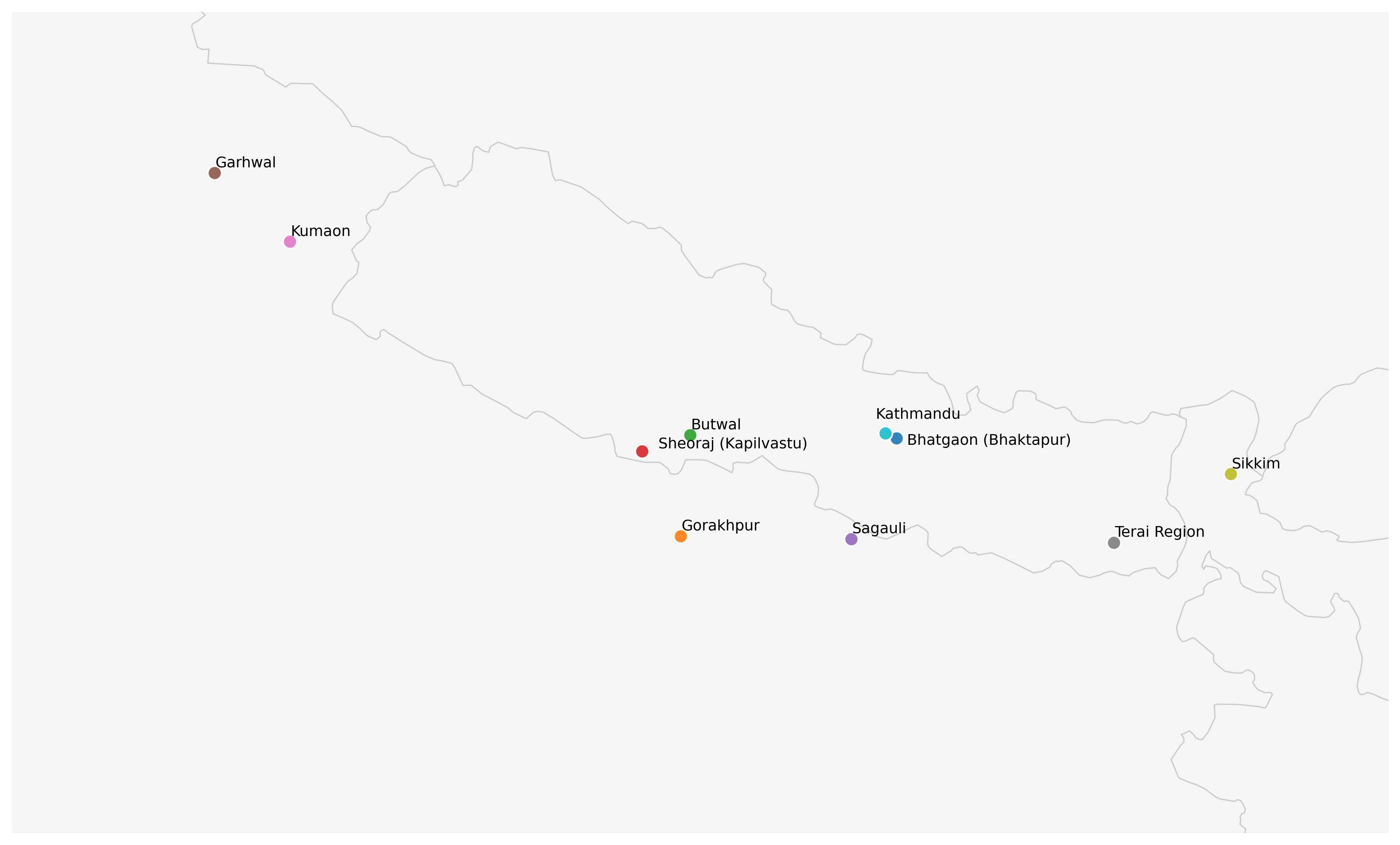
- 1760: Gorkhas gained control from Ranjit Malla of Bhatgaon
- 1801: English annexed Gorakhpur, bringing boundaries together
- 1813-23: Conflict began with Gorkhas' capture of Butwal and Sheoraj
- 1816: Treaty of Sagauli (favoured British)
- Nepal accepted British Resident
- Ceded territories
- Garhwal
- Kumaon
- Terai
- Withdrew from Sikkim
- British gained Himalayan access, trade routes to Central Asia, hill stations, Gorkha soldiers
Anglo-Burmese Relations
- Early 19th century: Burma's westward expansion conflicted with British interests
- British motivated by forest resources, markets, checking French ambitions
- Three Anglo-Burmese Wars led to Burma's annexation by 1885
First Burma War (1824-26)
- Burmese expansion + Occupation of Arakan and Manipur → threatened British territories
- 1824: British occupied Rangoon and within 72 km of capital at Ava
- 1826: Treaty of Yandabo
- Required Burma to pay compensation
- Cede provinces → Arakan and Tenasserim
- Abandon claims → Assam, Cachar, Jaintia
- Recognise Manipur as independent state
- Accept British Resident
Second Burma War (1852)
- Driven by commercial interests → British wanted hold of timber resources of upper Burma
- British occupied Pegu (coastal province of Burma)
- British overcame intense guerrilla resistance
Third Burma War (1885)
- King Thibaw's hostility and negotiations with rival powers led to annexation
- 1885: Invasion of Burma by British under Dufferin; Final annexation
- Post-WWI: Burmese nationalist movement joined with Indian National Congress
- 1935: Burma separated from India
- 1948: Burma gained independence under Aung San
Anglo-Tibetan Relations
- Tibet: Buddhist theocracy under ineffective Chinese suzerainty
- Curzon alarmed by Russian influence, sent Younghusband mission (1904)
- Treaty of Lhasa (1904)
- Tibet would pay indemnity of ₹ 75 lakh at 1 lakh per annum (later revised to ₹ 25 lakh)
- Indian Government would occupy Chumbi Valley for 75 years
- Tibet would respect Sikkim frontier
- Trade marts opened at Yatung, Gyantse, Gartok
- Tibet would not grant concessions for infrastructure to foreign states
- Britain gained control over Tibet's foreign affairs
- 1907: Anglo-Russian Convention required Chinese mediation for Tibet negotiations
Anglo-Afghan Relations
- 1828: Russian influence in Persia threatened British India
- Auckland's Forward Policy (1836): secure Afghanistan through treaties or annexation
- Dost Mohammed sought Russian help after British rejected demand to recover Peshawar from Sikhs
- 1838: British implemented forward policy through Tripartite Treaty
- Parties: British, Sikhs, Shah Shuja (deposed Afghan ruler living as British pensioner)
- Terms: Shah Shuja enthroned with Sikh armed help
- Company remained in background "jingling the money-bag"
- Shah Shuja
- To conduct foreign affairs with Sikh/British advice
- Surrendered sovereign rights over Sindh Amirs for money
- Recognized Sikh claims over Afghan territories on Indus right bank
First Anglo-Afghan War (1839-42)
- Despite changed circumstances (Persia lifted Herat siege, Russia recalled envoy) → British proceeded with forward policy to create barrier against northern aggression
- 1839: British army entered Kabul successfully
- 1840: Most tribes won over by bribes, Dost Mohammed surrendered
- Shah Shuja made Amir but was unacceptable to Afghans
- British withdrawal triggered Afghan rebellion, garrison commander killed
- 1841: British signed treaty with Afghan chiefs to evacuate and restore Dost Mohammed
- 1842: British plan failed, re-occupied Kabul
- British evacuated Kabul after settling with Dost Mohammed, recognizing his rule
Policy of Masterly Inactivity
- John Lawrence (1864-69) implemented masterly inactivity policy
- Non-interference in Afghan affairs following First Afghan War
- Conditions
- Frontier peace
- No foreign involvement in civil wars
Proud Reserve Policy
- British#Lord Lytton (1876 - 1880) implemented proud reserve policy
- Scientific frontiers (Strategically defensible border) and defined spheres of influence
- Invaded Afghanistan when Sher Ali accepted Russian but not British envoy
Second Anglo-Afghan War (1870-80)
- Sher Ali balanced Russia-British relations, refused British envoy
- British#Lord Lytton (1876 - 1880) invaded after Russian withdrawal, Sher Ali fled
- Treaty of Gandamak provisions
- Amir to conduct foreign policy with Government of India's advice
- Permanent British resident stationed in Kabul
- India to provide support against foreign aggression and annual subsidy
- Yakub Khan soon abdicated under popular pressure
- British recaptured Kabul and Kandahar
- Aftermath
- Abdur Rehman became new Amir
- Lytton's plan to dismember Afghanistan abandoned
- Ripon established Afghanistan as buffer state
- After WWI and Russian Revolution (1917), Afghans demanded independence
- Amanullah declared war on British
- 1921: Afghanistan gained independence in foreign affairs
British India and NWFP
- 1843-1849: Sindh conquest and Punjab annexation extended British control
- British encountered independent Baluch/Pathan tribes claimed by Afghanistan
- 1891-92: Hunza + Nagar occupation alarmed Abdur Rahman
- 1893: Durand Line established border, increased Amir's subsidy
- Tribal uprisings continued through 1898 despite agreement
- 1899-1905: Curzon replaced troops with tribal levies under British command
- Created NWFP under direct Government of India control
- 1932: NWFP became governor's province
- 1947: Province transferred to Pakistan
